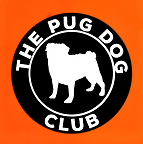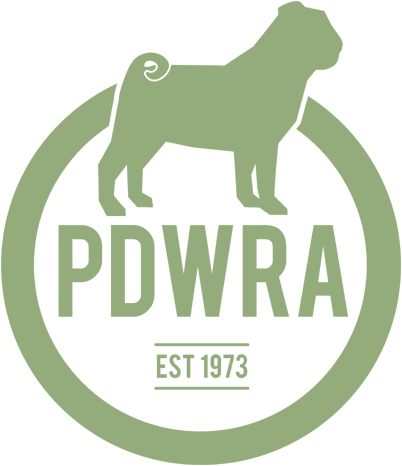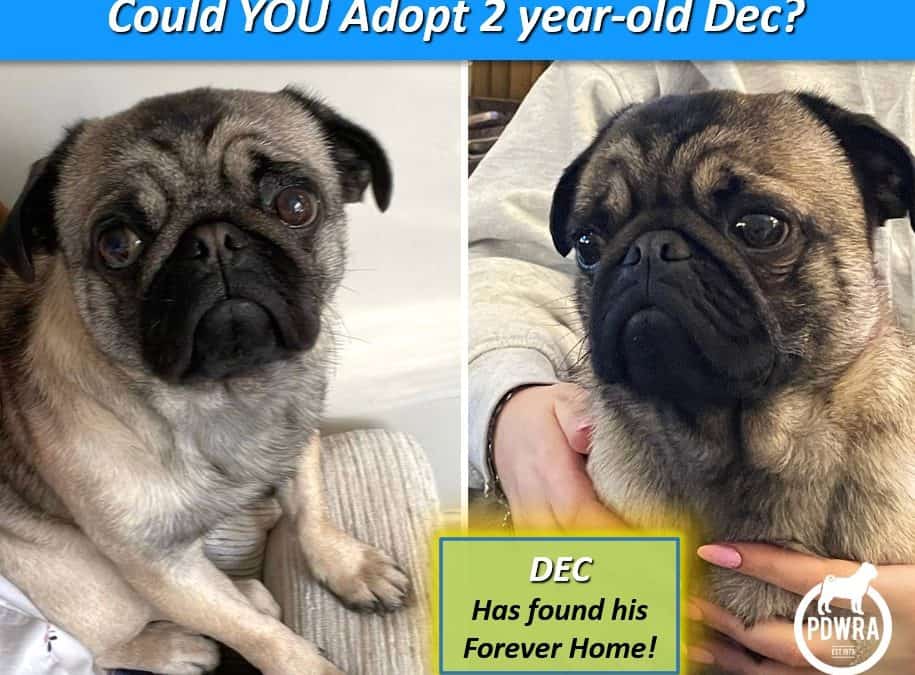
by Yasmin | 28 May, 2025 | Pug Home Appeal, Blog, Rescue Stories
👏 ** GREAT NEWS, Dec has his Forever Home lined up, following an amazing response in Applications for him, Lucky Boy! ** 👏
***
APPEAL INFORMATION:
This is two year old Dec who’s looking for his adoptive home!
He’s an affectionate boy who enjoys a fuss being made of him, as well as companionship.
🐾 Dec is very active and enjoys long walks.
🐾 He can live with kind, respectful children of five plus years.
🐾 Dec can live as an only dog, or potentially with another compatible dog who will appreciate his youthful excitability.
🐾 He will need to be fed separately, as is very food-orientated.
🐾 Unfortunately, Dec does not like cats!
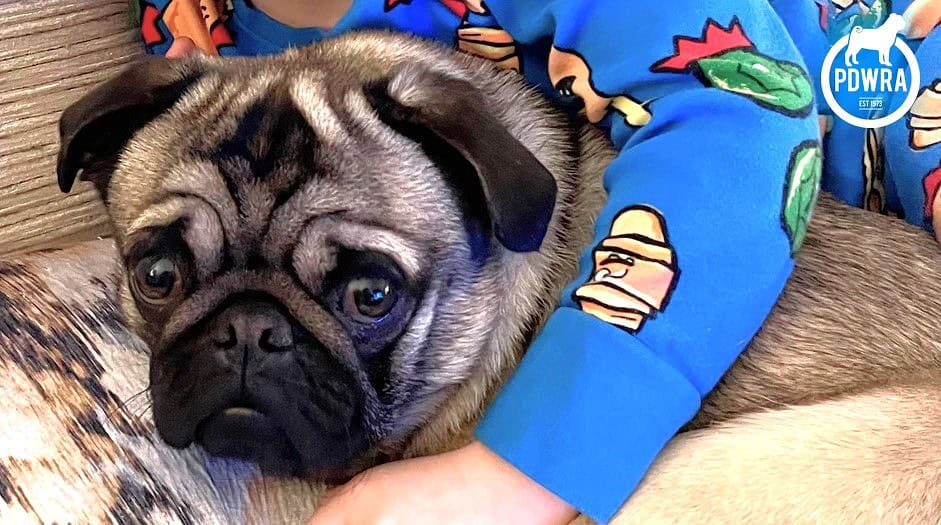
Dec is neutered, vaccinated and in good health.
His housetraining is work in progress. Walking regularly helps and he really loves his walks.
Patience and routine is a must for him.
Dec responds to basic commands though training to wait for treats for example will need work on! 😄
******
Dec responds to basic commands though training to wait for treats for example, needs work on!
He can be nervous/scared if unsure, or hears loud noises or someone approaches suddenly though can be comfortably examined by a vet.
This delightful young boy will bring a lot of joy and life to any home!
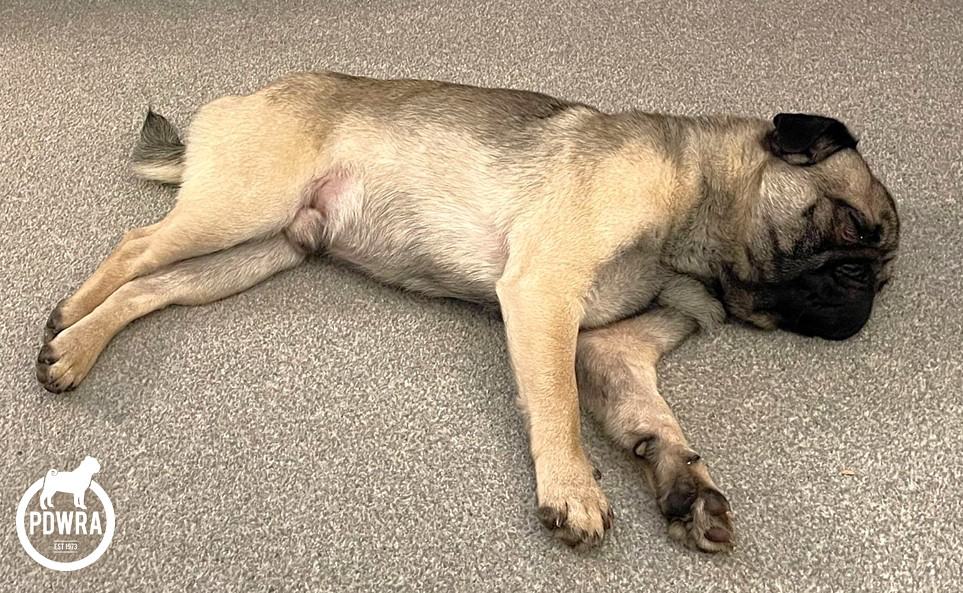
Thank You!
If you have any specific questions about Dec, or your application, please email Jane & Cara at: central@nullpugwelfare-rescue.org.uk
Please ensure you have read PDWRA’s Guidelines & Conditions for Adopting, at: https://pugwelfare-rescue.org.uk/adopting-a-pug/
******
Please also take a look at our sample of happy, successful Rescue & Adoption Stories, to see the mutual joy that adopting brings, at:
https://pugwelfare-rescue.org.uk/category/rescue-stories/

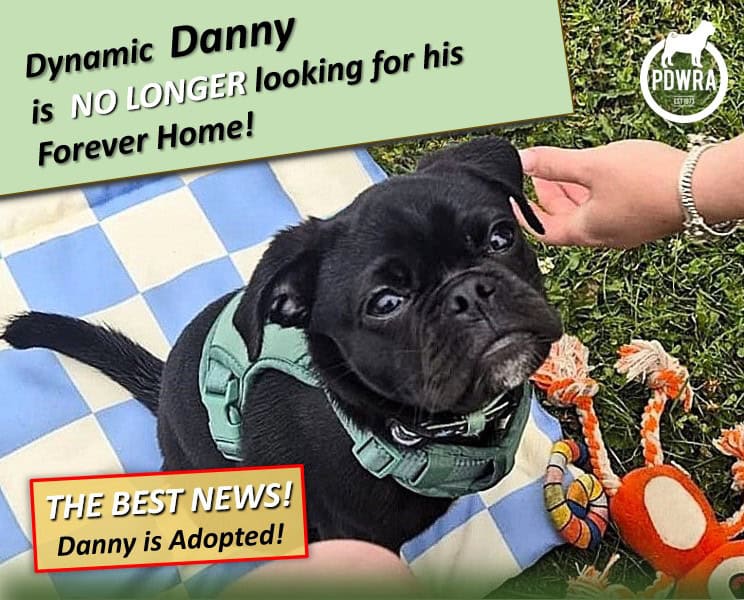
by Yasmin | 20 May, 2025 | Pug Home Appeal, Blog, Rescue Stories
👏 ** WONDERFUL NEWS UPDATE: Danny has been ADOPTED! ** 👏
THANK YOU for all your responses!
*****
APPEAL INFORMATION:
This is Danny, a 1 year old bundle of fun, recently neutered & up to date with all his jabs.
Danny loves other dogs. He just loves to play but gets frustrated & barky if other dogs don’t want to play as energetically as him.
So, Danny is looking for a young, fit playmate or two maybe, which would suit him best. He probably wouldn’t cope well as an only dog as he’s always looking for energetic stimulation & fun!
He’s unfortunately not a cat-person though!
He likes to carry objects around but he doesn’t chew them & he’s also tried agility which would be very good for developing his skills for this.
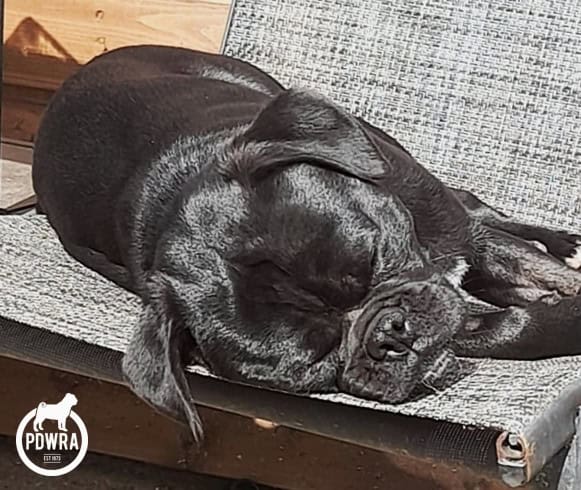
Because of the full and busy home where unfortunately Danny was crated a lot, he does have separation anxiety & shouldn’t be crated any more. What he needs is time & attention with adults at home a lot or working from home.
This also means he is very wary of children, therefore a home with no children, or calm, responsible older children (over 10yrs) would be better suited.
Likewise, Danny is initially nervous of men but will be fine once he learns to trust them. He does travel well in a car.
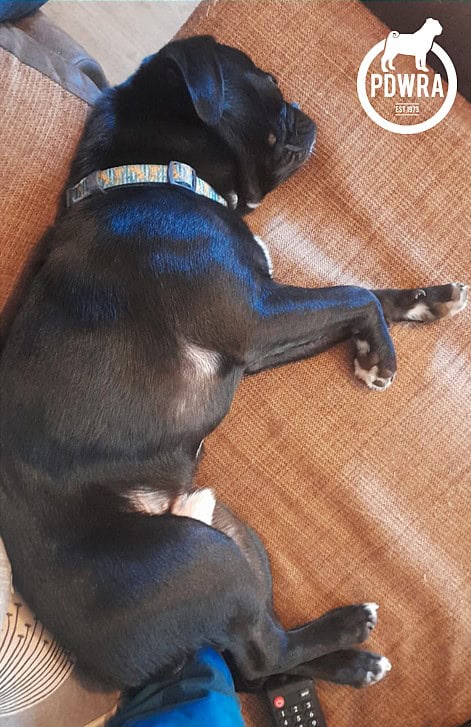
Danny is a lovely young boy who just needs a family to love him & give him all the attention and security he needs, with opportunities to release his boundless energy & just enjoy him!
It will be a win-win for whoever adopts our dynamic Danny!
If you have any specific questions about him, or your application please email Lisa at: east@nullpugwelfare-rescue.org.uk
Please read our Guidelines & conditions for Adopting, at: https://pugwelfare-rescue.org.uk/adopting-a-pug/
******
Also, you can see a sample of happy, successful Rescue & Adoption Stories, that show the mutual joy that adopting a pug brings, at:
https://pugwelfare-rescue.org.uk/category/rescue-stories/

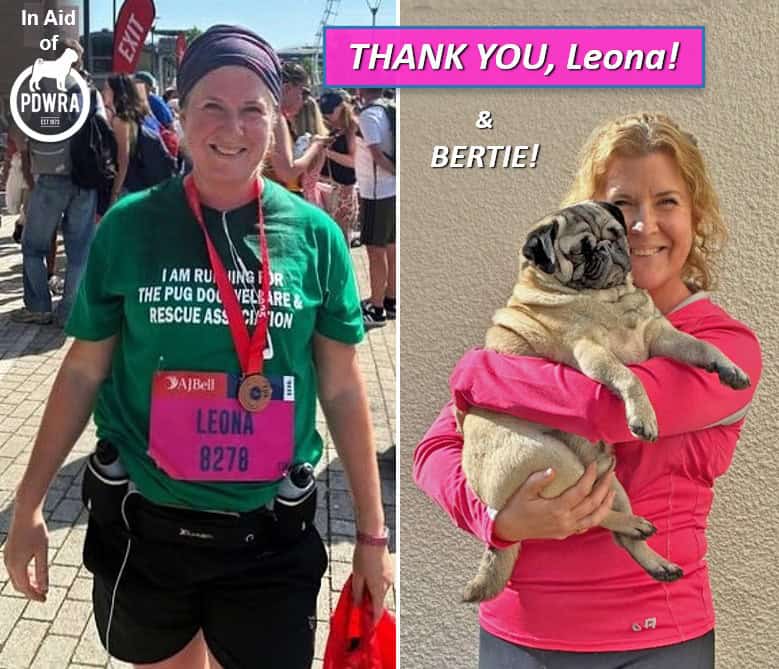
by Yasmin | 13 May, 2025 | Blog, News, Volunteering, Fundraising
Leona Black is fundraising for The PDWRA
On May 11th, Leona ran in the AJ Bell Great Bristol Run 10K in aid of the PDWRA!
Leona says ‘I’m running to raise money for this wonderful charity that I adopted our pug Bertie from.
They helped me daily whilst I got to know Bertie and paid for the operations he needed, which cost a lot!
They do this for every pug in their care that needs medical help. I also volunteer with them, helping to find new homes for pugs.
10km is a lot for me – I’m currently at 7km (with a couple of breathers 😆) and plan to up the distance a little bit each time I run along the Bristol Portway.’
*****
So a Very Well Done & Thanks to Leona from all at PDWRA including the pugs she will be able to help!
Leona finished with lots of support, saying, “It was so great, and I’ve raised £680 now! Thank you so much for all the love and support xx “
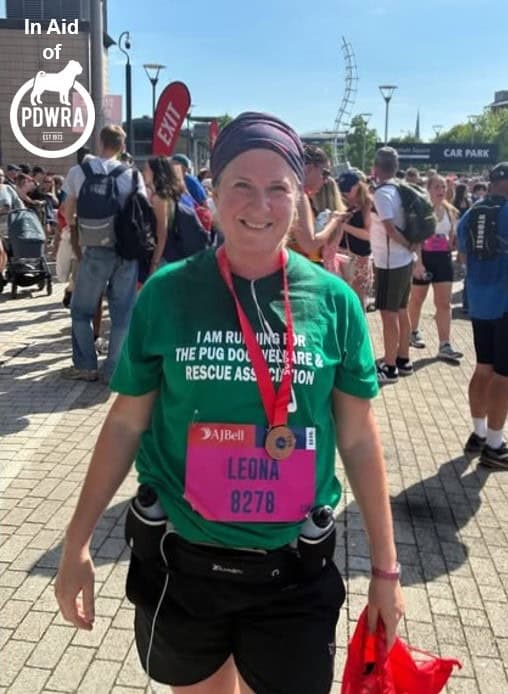
Looking at Leona’s Fundraising page on Tuesday 13th her Total had increased to: £800.14 + £177.25 Gift Aid!
Please continue to Donate!
Just click below to visit her Just Giving page here: Leona Black is fundraising for The PDWRA
Every little helps!
********
For more information and examples of how to raise funds for PDWRA, please go to:
Fundraising & Events 2025 | The Pug Dog Welfare & Rescue Association
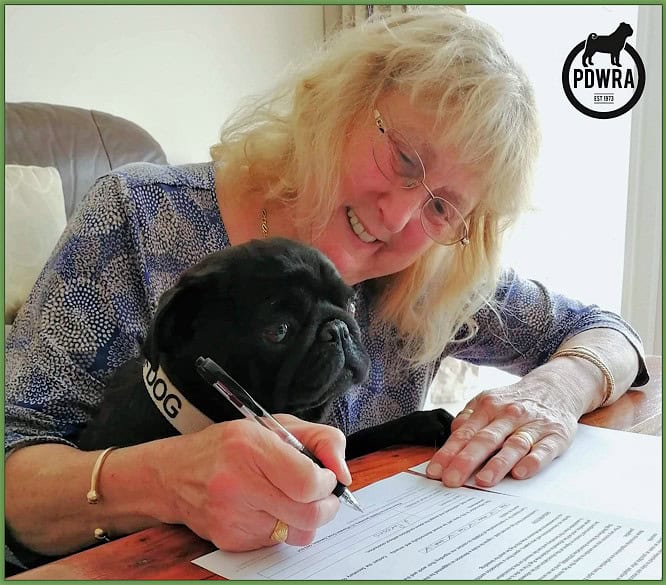
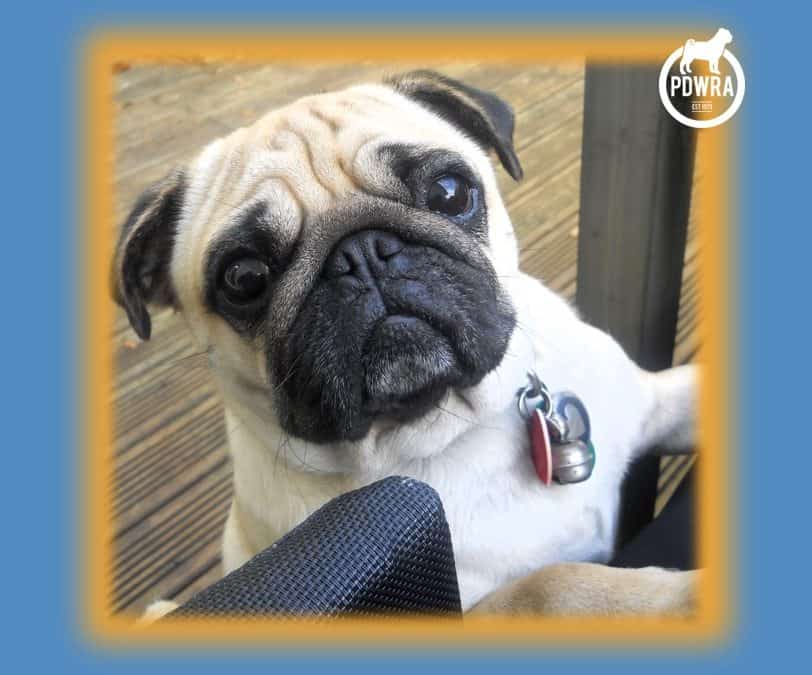
by Yasmin | 11 May, 2025 | Blog, Rescue Stories, In Memoriam
By Donna:
In March we had to say goodbye to our beloved 13.5yr old pug Frank.
Frank was adopted from PDWRA in 2014 when he was just 2.5yrs old and it was the single most best decision we ever made!
He slotted into our family life as if he’d always been a part of it.
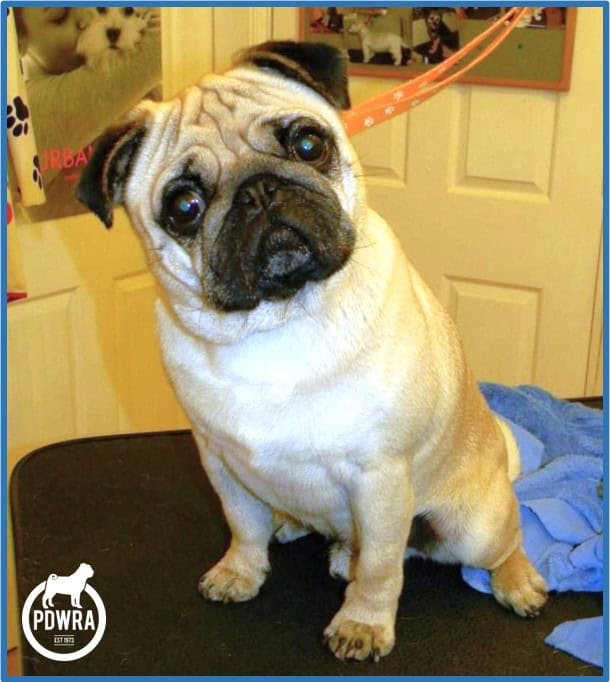
Like any pug, his presence and personality were huge and in the village we lived in until our early retirement. Everyone knew and loved him, he was our superstar!

After we retired and relocated, Frank was becoming quite stiff on his hind legs and a trip to the vets down here confirmed osteoarthritis, prescribed Onsior and checked 6 monthly.
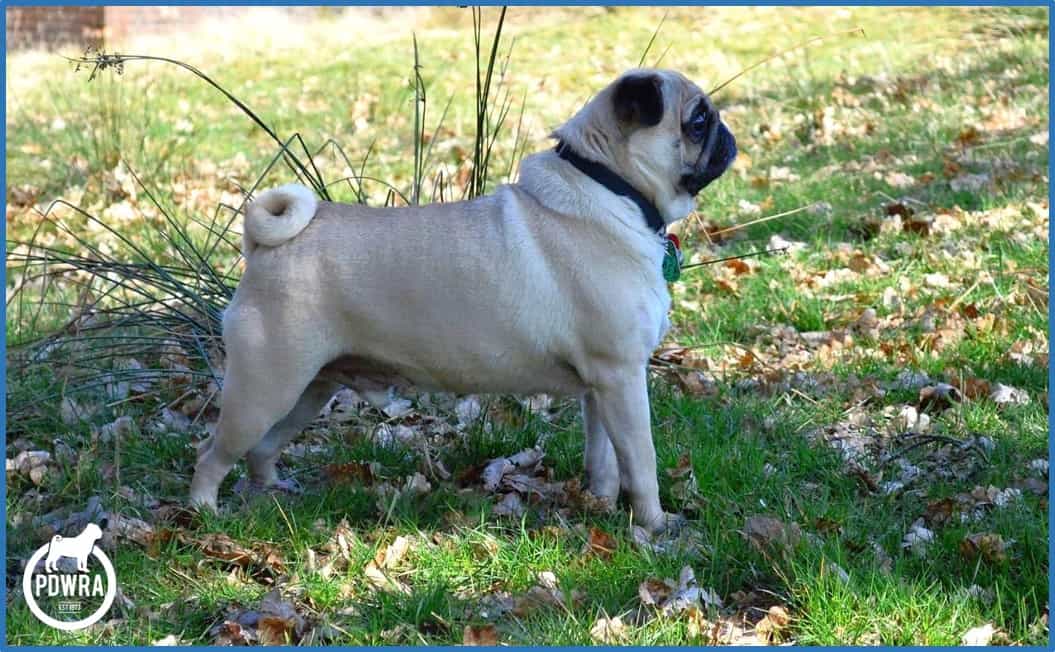
Frank improved greatly on this for a while, then later was diagnosed with dementia, loss of some sight and most of his hearing. At 13yrs old, he was still a happy little chap and coping well with his ageing.
Sadly though, 6 months later he went into respiratory distress, and along with our vets, who were wonderfully supportive, agreed it was the right time to say goodbye to our wonderful little man.
Frank went peacefully surrounded by his family and all the love in the world which he so richly deserved.
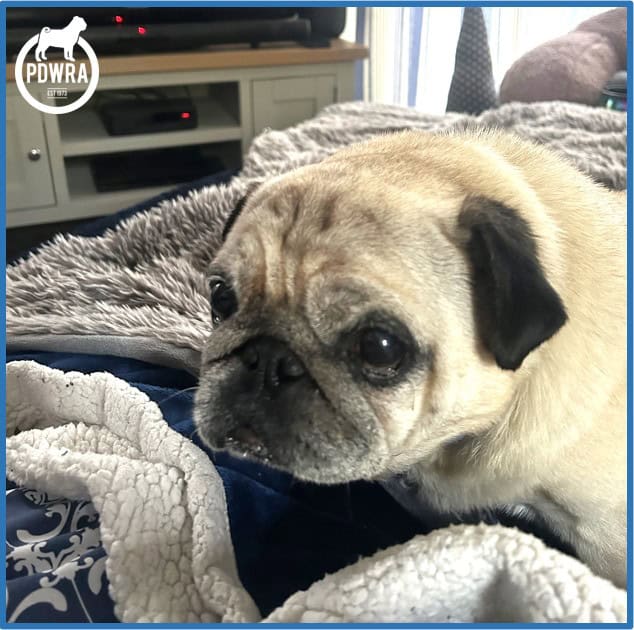
FRANK
You left owing us nothing but to you, we owe the world. 💔
The stained corners of furniture from the joy of rubbing your face into anything and everything, hair, goodness, the hair, it fell on and into anything and everything.
The cacophony of weird indescribable noises and incessant barking at Eastenders theme tune.
The constant tippy tapping nail noises on anything that wasn’t carpeted. I moaned, probably every day of the 11yrs we had you about it, but I would have all that back in a heartbeat Frank, rather than the silence we’re left with today.
R.I.P my wonderful, snuffly, funny, gentle little chicken nugget. You will be missed more than you will ever know….until we meet again my friend. 💔💔
Your Mum & Dad,
Donna & Brian.
I would also like to thank the PDWRA for their faith and trust in us as adoptive pug parents. It was an honour and a privilege to have known Frank for 11yrs, and to have cared for him. He was the link in our family, he made our family what it is today, so much so that my eldest daughter, her partner and my two young granddaughters are now the proud adoptive parents of a wonderful pug!
******
To pay tribute to your sadly lost and beloved PDWRA pug on this, our dedicated In Memoriam web page:
https://pugwelfare-rescue.org.uk/category/in-memoriam/
please email your story, or whatever you would like to say about them, with photos,
to: yasmin.t.pdwra@nullgmail.com
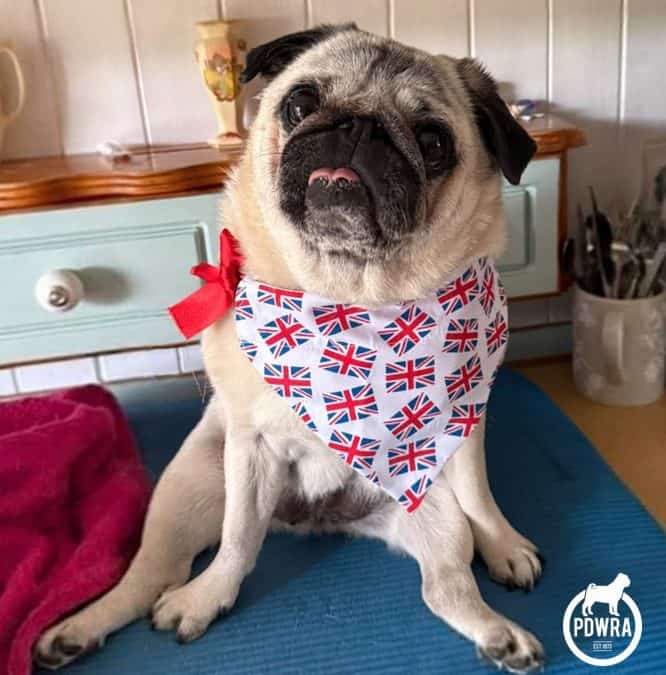
by Yasmin | 8 May, 2025 | Blog, News, Volunteering, Fundraising
🎉This is Daphne, the most sociable PDWRA pug, joining in VE 80th Anniversary celebrations wherever she can! 🎊
Daphne is one of our many happily adopted pugs who we appealed for a home for last year.
Ever since, Daphne’s Mum, artist Shirley, inspired by Daphne of course, has been generously using her talent to donate funds to PDWRA. Many pugs are drawn each month but not restricted to them, any breed, or animal included!
Shirley donated over £2,000 last year alone & she’s drawing every week from her order list!
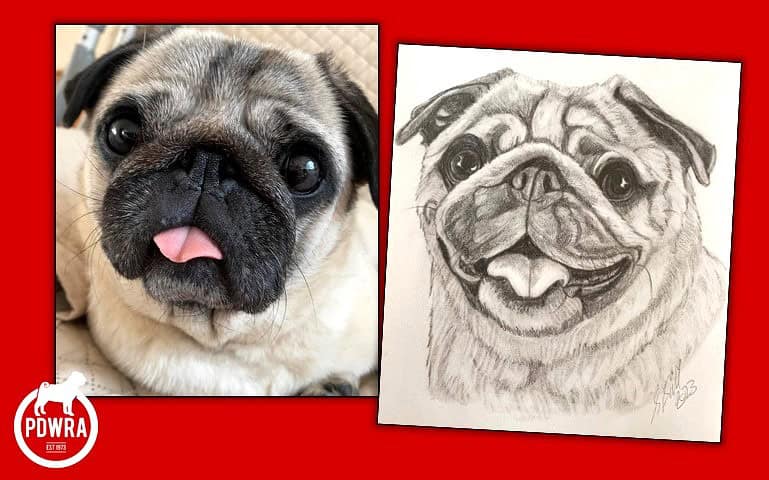
Daphne!
If you would like to own a unique and personal portrait of any four-legged animal, please don’t hesitate to place an order.
Each portrait costs £15 only, where Shirley donates £10 directly to PDWRA, and £5 covers post, packaging & materials. All you need to do is provide the photo you wish her to use.
Please do so from within PDWRA’s Facebook Mega Auction Group: https://www.facebook.com/groups/242845766241493/permalink/1899302960595757
You can private message Shirley from there.
We can’t thank Shirley enough for her generosity, as well as the joy she has brought to so many.
https://pugwelfare-rescue.org.uk/order-your-unique-pet-portraits-while-donating-to-pugs/
********
To see why fundraising is so essential for our work in rehoming pugs plus other ways you may be able to raise funds to help, please see:
https://pugwelfare-rescue.org.uk/fundraising-events/
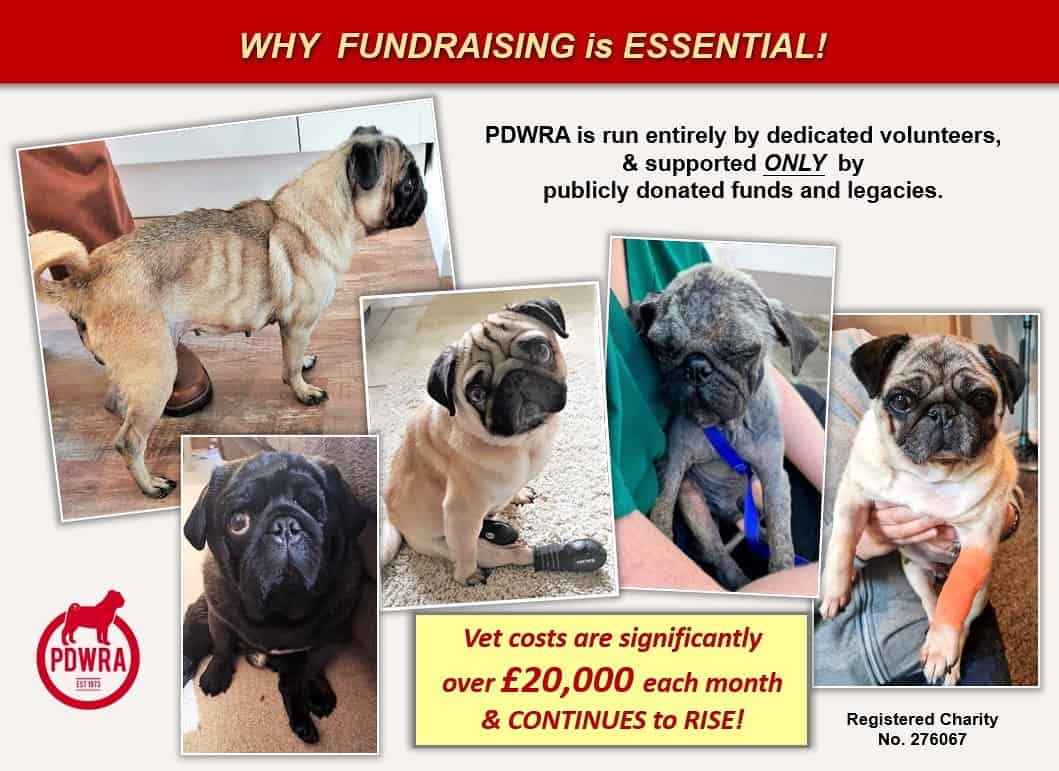
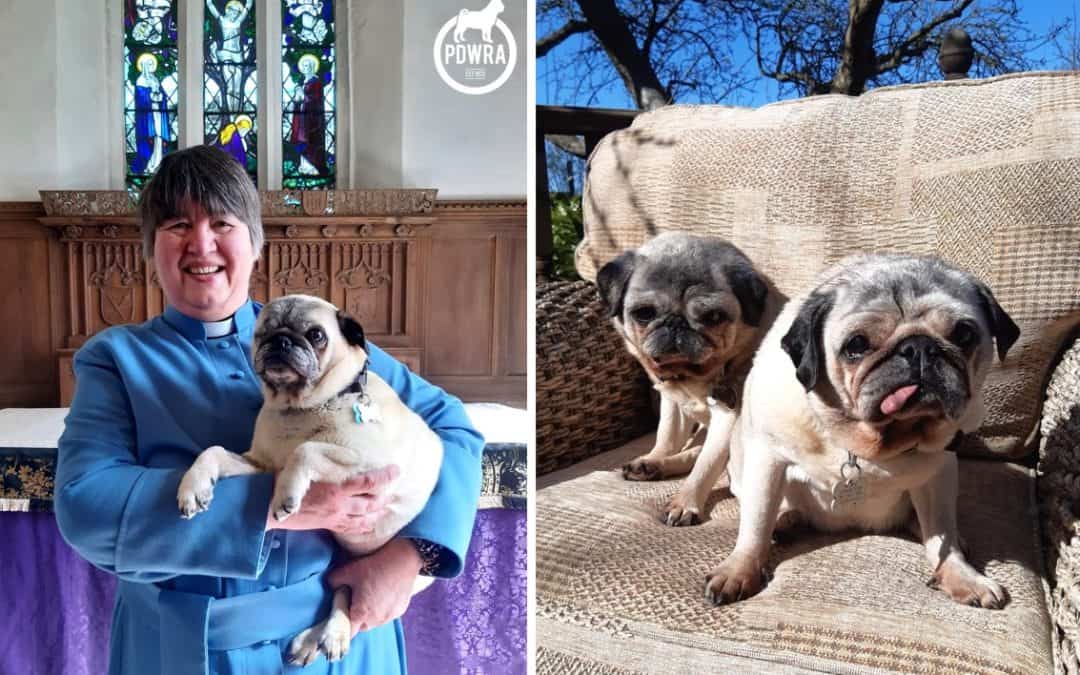
by Yasmin | 29 Apr, 2025 | Blog, News, Rescue Stories, Volunteering
Speaking from one dog collar to another – The joy of being a long-term fosterer with PDWRA…
It was the run up to Christmas 2023, late evening and I needed a break from sermon writing, so started surfing the internet, and because of my interest in pugs came across the PDWRA, and their appeal for fosterers. I can do that – I thought. My work is based at home; the house is pug friendly with a third of an acre of secure garden. Most importantly was I needed to check with Horace and Doris, the resident pugs, and Big Trevor who I was looking after for a member of my congregation (who incidentally ended up staying). Permission granted and I completed the forms; a home check followed, and the rest as they say is history. My first foster pug came in early February, a lovely 9-year fawn pug. She settled in straight away and a home was already lined up for her. She stayed for a few days holiday before going to her forever home.
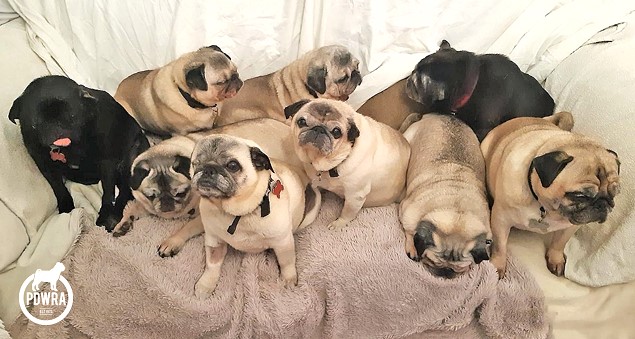
Julie’s full Grumble!
After speaking to my regional co-ordinator Dee, I shared my love of those pugs that had additional needs.
Having worked as a regional fundraiser for a national animal welfare charity for 15 years it saddened me when those that are elderly, not attractive to look at, or have medical or social needs are overlooked in favour of the younger dogs, when often all they need is someone to understand and love them for who they are. These are the pugs that I have a passion for, have experience of caring for and am happy to share my life and my home with.
I didn’t need to wait long. Dee rang to ask if I would take a bonded pair. Of course, was my reply. My first black pugs – Cissie and Ada, (mum and daughter) joined us. Cissie was 13 and Ada 11 and a half. Both were wonky on their back legs and continence was becoming an issue, but apart from that they were absolutely fine. They have been a joy to have around and can still get about. Howard and Hilda came a few weeks later. Howard was 14 and Hilda 11. Both settled in immediately. They still enjoy a toddle around the village.
Betty came in the summer, an 11-year-old who came from another region. After a dental she became one of the more lively pugs in the grumble, and last but definitely not least came Mr Godfrey, who arrived at the end of the summer. He was overweight and struggling to walk. A trip to the vet diagnosed Degenerative Myelopathy. A strict diet meant he has lost weight, has regular physio and hydrotherapy and started to get around on his wheels and a happier pug you couldn’t wish to meet. Feeding time is organised and everyone waits their turn.
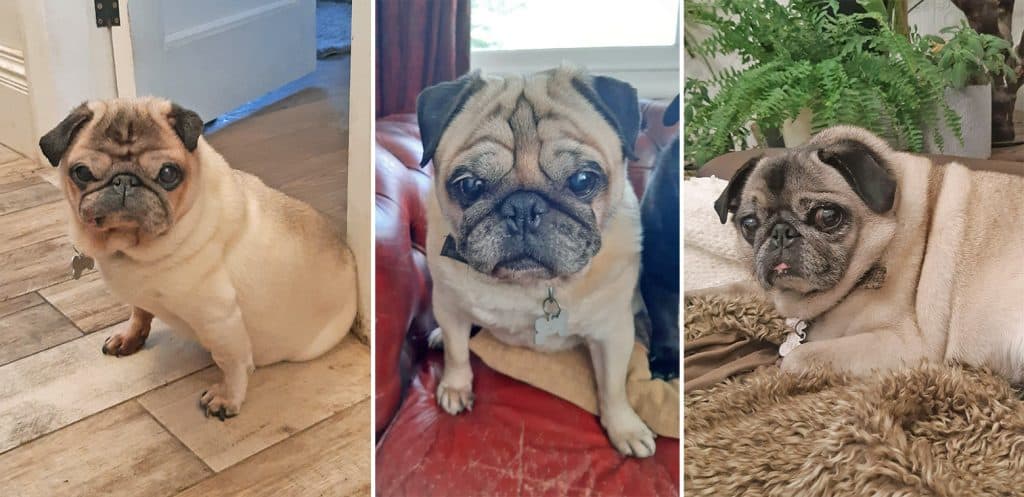
Mr Godfrey, Big Trevor and Doris
As everyone who lives with a pug will tell you, they are unique characters, and you soon see past their age or condition. I don’t notice Horace’s one eye, liver shunt and his post clip alopecia, Big Trev’s Sudden Acute Retinal Degeneration, (He lost his eyesight totally in just over a week last month and is now learning to get around blind, but the rest of the grumble support him). They are a joy to come home to and always lift the spirit.
My job enables me to sometimes take them to work with me and visits to care homes for an afternoon of ‘Pugs and Mugs’ are always popular where the everyone gets to fuss a pug and share a mug of tea and a cake (the pugs ensure there are no crumbs on the floor!), and pet blessings are always fun to do, and mine get to take the service with me.
Of course, there is the sad side when they make the journey over the rainbow bridge. As I was writing this article I had to wave goodbye to Betty, as she had developed a suspected brain tumour and very suddenly went downhill. I stayed with her till the end, and she spent her final hours before and after crossing with her grumble family. As sad as it was, I am so grateful for the time she spent with all of us and the difference her life made to ours, and it makes me even more determined to give these older pugs the best quality of life they can possibly have for as long as they can.
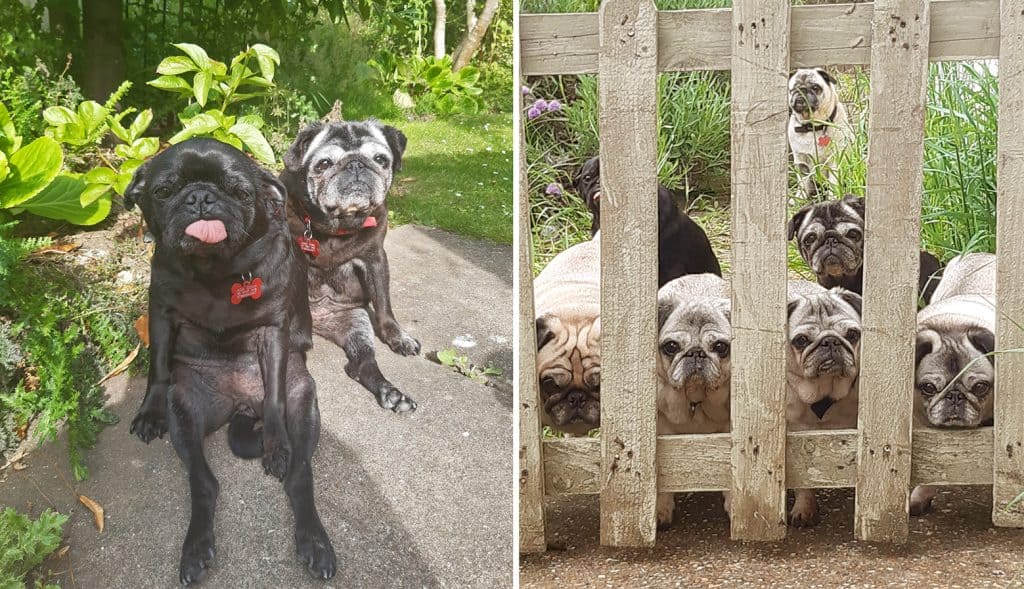
Cissie & Ada, and the Grumble peering through the gate
Myself, like all other volunteers; fosterers, fundraisers, drivers, vets, trustees, co-ordinators are each a cog in the wheel that is PDWRA and a big thank you needs to go to those behind the scenes who by their own volunteering allow the charity to continue to do what it does best, caring for pugs. But this can only happen alongside a sustainable income, which is why I also advocate leaving a legacy, and / or regular giving to enable the charity to continue in the future.
I see my role as a long-term fosterer as a privilege and I keep in regular contact with Dee, my regional co-ordinator and send updates all of the time, the charity support their medical needs, and Abbey Vets have been an amazing support. Through PDWRA I have met some wonderful people and pugs, and this has become a holiday home for some of the fostered / adopted pugs with additional needs. It all adds to the grumble and variety.
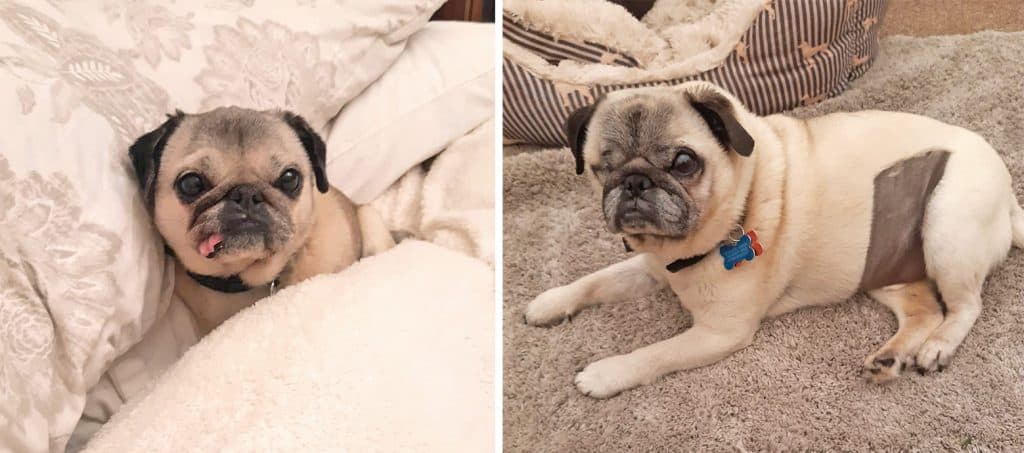
Betty & Horace
To anyone considering fostering, I would say, don’t overlook the bonded pairs, those with additional needs, they are a joy, and the elderly – with age comes wisdom
The only thing is you might need to get is a bigger sofa, so that there is enough room for everyone!
********
For more information about Fostering and to apply, please see:
https://pugwelfare-rescue.org.uk/fostering-a-pug/
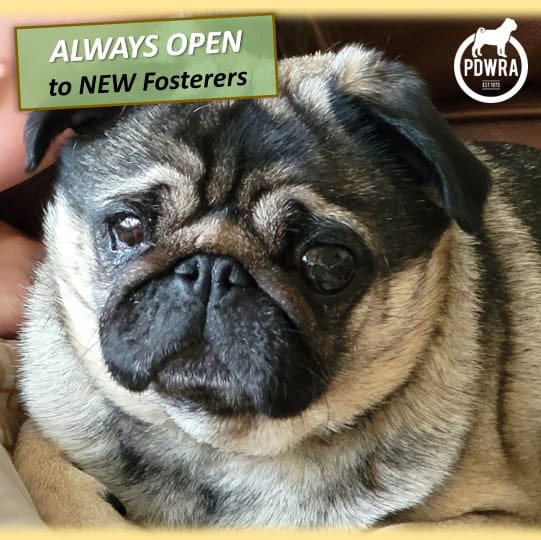
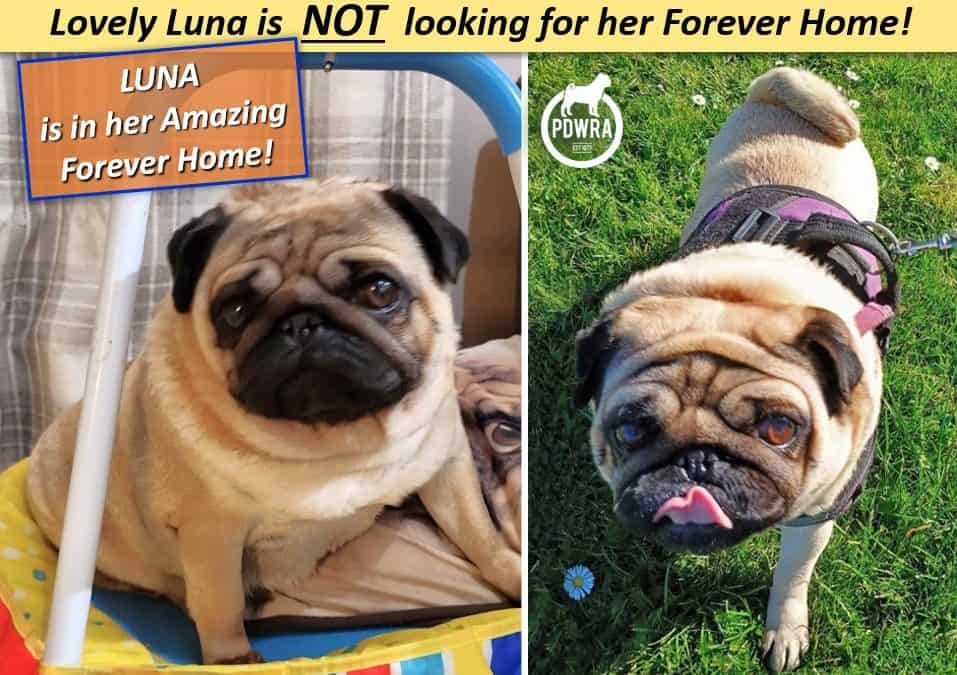
by Yasmin | 25 Apr, 2025 | Pug Home Appeal, Blog, News, Rescue Stories
👏 THE BEST NEWS! 👏
Luna has an amazing, fun home with furry companions to play with!
*****
ORIGINAL APPEAL INFORMATION:
Otherwise known as Looney Tunes, the lovely Luna is ready for her adoptive home, having been in foster due to her Mum passing away..
Luna is seven years old and spayed.
She can live in a new home as an only pug, or with a sociable dog.
She will tolerate cats, but may chase them at first!
Luna can live with children, but can be a little over zealous with her affections.
She is quite a character, and is very typical of the stubborn, funny, cheeky, contrary and affectionate pug.
******
Luna likes to march to the beat of her own drum, and won’t necessarily follow any requests!
She is fully housetrained and enjoys her walks, also travels well in the car.
She’s enjoying her stay in foster, in central England as you can see from the videos.
Luna will make a wonderful, fun and loving addition to any home!

Please also read our Guidelines for Adopting, at: https://pugwelfare-rescue.org.uk/adopting-a-pug/
If you have any questions regarding Luna’s adoption, please contact Jane at: Central@nullpugwelfare-rescue.org.uk
*** APPLICATIONS are now CLOSED for Luna ***
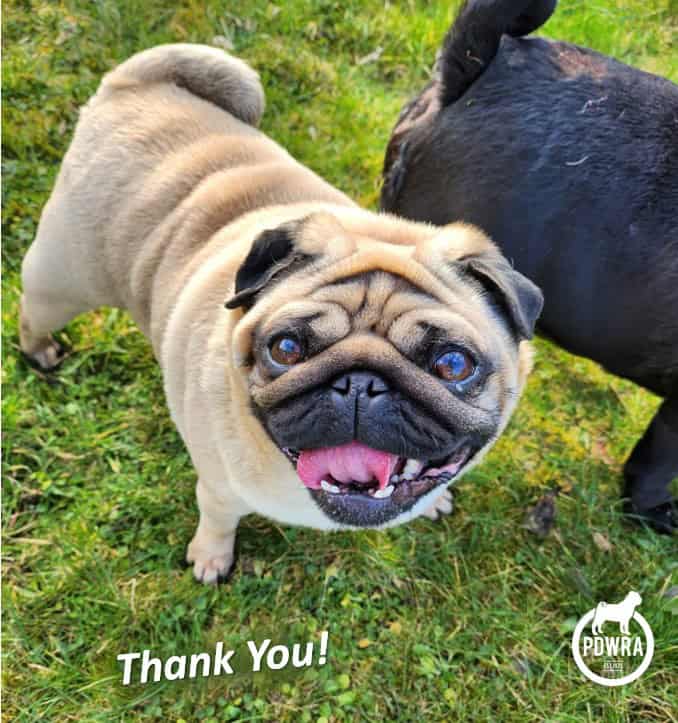
******
Please take a look at just a small sample of happy, successful Rescue & Adoption Stories at:
https://pugwelfare-rescue.org.uk/category/rescue-stories/

by Yasmin | 20 Apr, 2025 | Blog, News, Pug Health
HAPPY EASTER!
Wishing everyone a Very Happy Easter. With special wishes and thanks to all of our loyal Supporters and dedicated Volunteers & Donators, who make helping Pugs in Need, possible!
Here are Teddy, Ruby and Mildred, gorgeous pugs from our PDWRA family’s, Mega-Auction team, getting into the spirit for the Easter Weekend.
To join in on their activities, they are open and active with new lots listed on Easter Monday and a prize raffle ending in the evening:
As Easter temptations will be around, please be vigilant around them for a fun & safe time, particularly if Easter Eggs or children are around.
Remind visitors what they’re not allowed to eat particularly.
FOODS they should not eat:
– Chocolate, lying around, discarded or forgotten out on Easter hunts!
– Fruit or Simnel cake, hot-cross buns anything with sultana’s, currants and raisins (grapes)
– Traditional roasted poultry where bones can easily splinter
– Stuffing, gravy, anything which may contain onion, chives, garlic.
– Other foods, such as certain nuts, blue cheese, fatty and salty foods
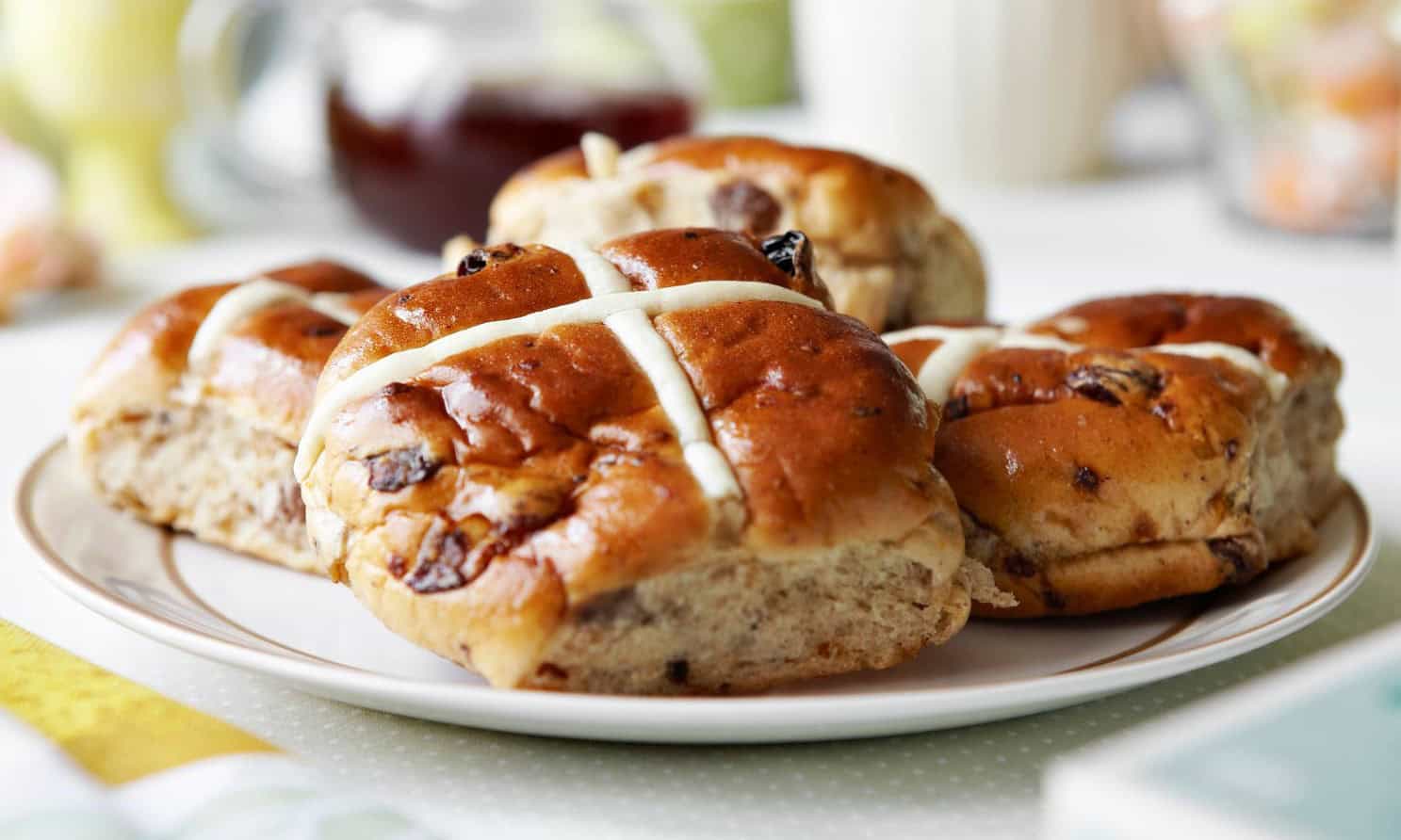
CHOCOLATE:
Most of us know to keep Easter chocolate away from them, but they will seek things out with their highly sensitive sense of smell.
Theobromine in chocolate is a stimulant. It may cause excitability or muscle twitching, tremors, even fitting, or they may have an increased heart rate.
They may initially be sick, but don’t try to make them sick. If vomit is frothy and foamy it could get into their lungs, making matters worse.
Other signs might include drinking a lot, dribbling, not walking in a straight line and fast breathing. If enough is eaten then the effects can be severe or even fatal.
Some sugar-free chocolates contain xylitol, which is an artificial sweetener especially poisonous to dogs. It can cause a dog’s blood sugar level to drop to dangerous levels, also possibly liver failure.

Although chocolate foil wrappers are not poisonous, they can cause an obstruction if eaten. This can be dangerous enough to require surgery. Signs of an obstruction may include being sick, being tired, they may be off their food, or finding it difficult to go to the toilet!
If you suspect your pet may have eaten chocolate, keep the packaging and call your vet immediately. Help them regarding the type of chocolate that’s been eaten (dark, plain, milk, white etc.) and how much has been consumed.
PDSA: Learn more about chocolate toxicity and the signs and symptoms: http://pdsa.me/bUYl
********
For more information about Easter and Spring hazardous temptations, please see:
Spring Hazards & temptations! | The Pug Dog Welfare & Rescue Association
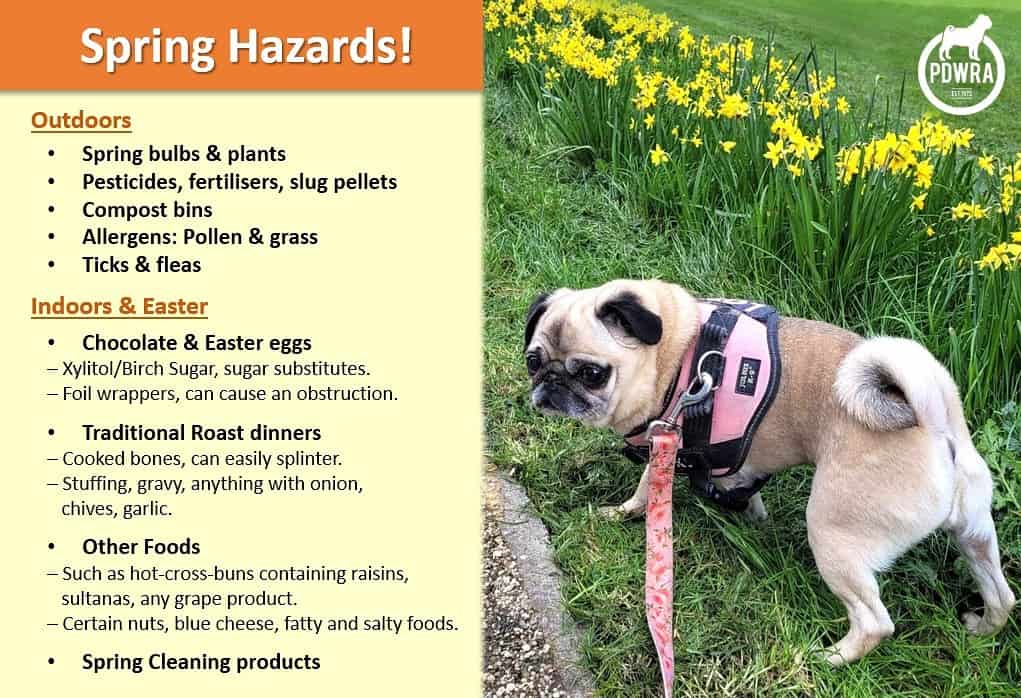
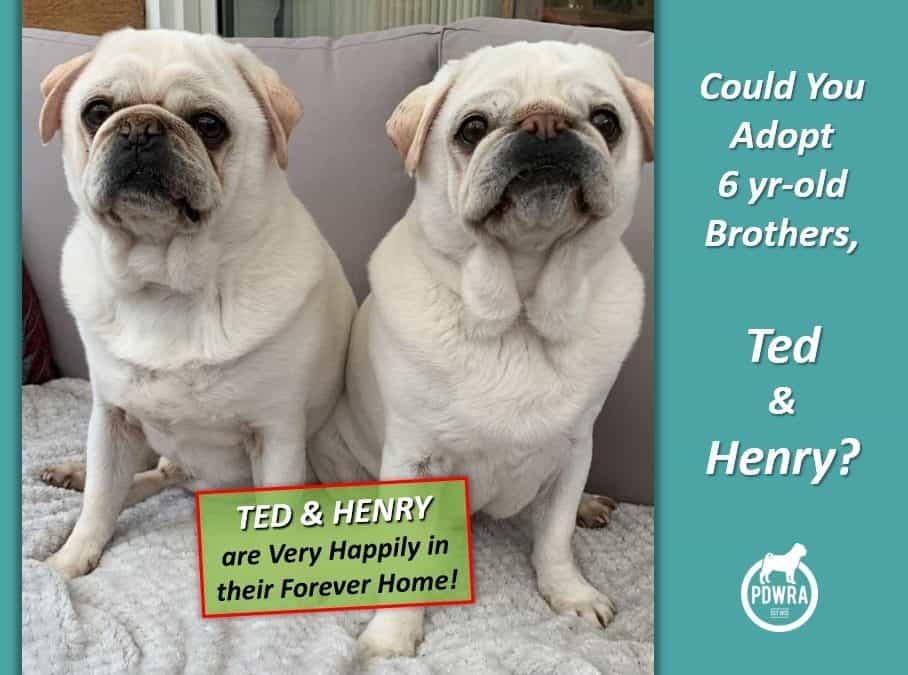
by Yasmin | 15 Apr, 2025 | Pug Home Appeal, Blog, News, Rescue Stories
👏 THEY’RE NOT LOOKING ANY MORE! 👏
We are delighted to say that Ted & Henry are settling in very well, into their Forever Home.
*****
APPEAL INFORMATION:
Due to family bereavement, these lovely 6 year-old brothers, Ted & Henry, are looking for their forever home together.
Gentle, loving, very well behaved and completely house-trained they would make the perfect companions and suit a variety of households.
Quick to adapt to new routines, the boys are also great with other dogs and with children of all ages. They have no fear of household noise and are good on or off lead.
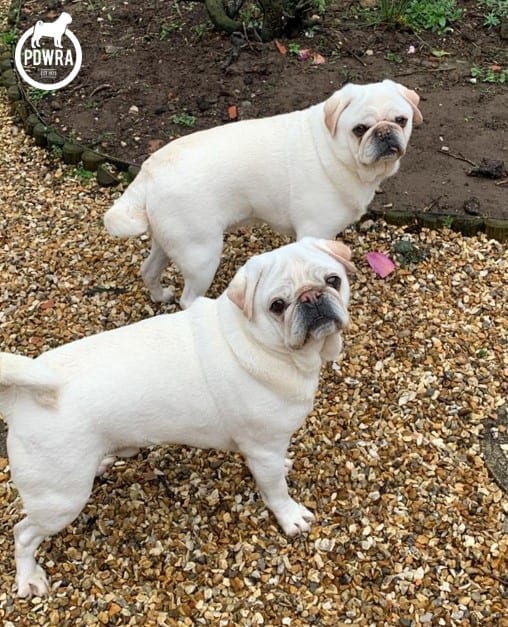
Henry is the leader of the two although he is slightly smaller. Ted will not go on a walk without him and they keep a close eye on where each other is at all times, definitely bonded-brothers.
The boys both love their walks. Ted is a plodder and sniffer while Henry has a slightly quicker pace though neither are sprinters!
Both Ted and Henry have the sweetest personalities, affectionate and gentle and very happy snuggling up on the sofa in the evening.
You are guaranteed to fall in love with them straight away!
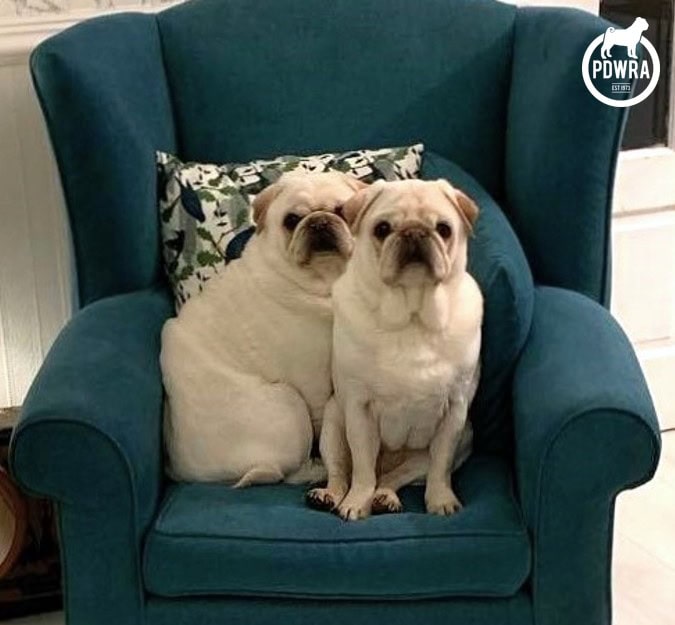
It will be a very lucky household indeed that gives a forever home to these 2 beautiful boys.
If you have any questions about them, please email Helen at: veterinary-advisor@nullpugwelfare-rescue.org.uk
Please Note we currently have sufficient applications for them & are not accepting any more at this time.
Our Guidelines for Adopting, including for Bonded-Pairs, are at: https://pugwelfare-rescue.org.uk/adopting-a-pug/
** We offer A £100 discount (£50 per pug), when adopting a Bonded-Pair of Pugs! **
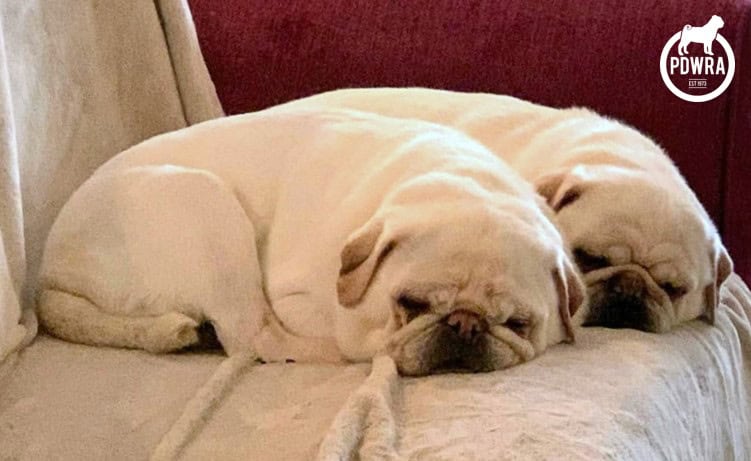
Thank You!
******
To see the difference adoption can make to your life and theirs, see some of our heart-warming Rescue & Adoption Stories for Bonded-Pairs at:
Perfect Pairs | The Pug Dog Welfare & Rescue Association
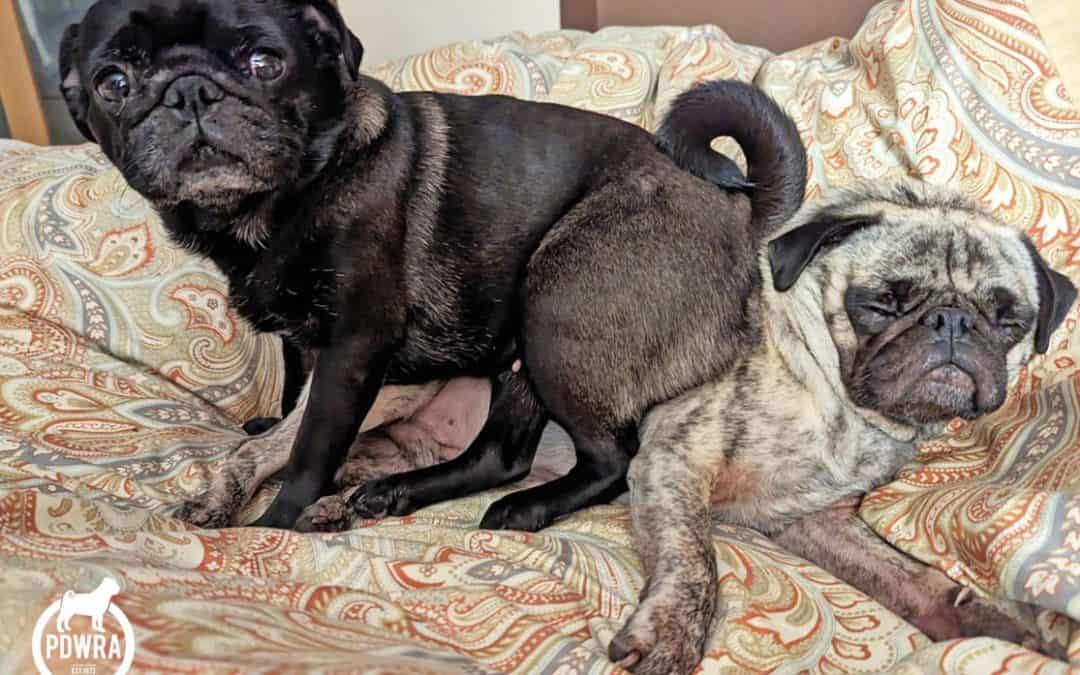
by Yasmin | 15 Apr, 2025 | Blog, Rescue Stories
How did you first hear about the PDWRA?
My daughter Amy, achieved her long held desire to own a pug in 2018. Now 30, and having wanted one since she was 10, she knew all about their little ‘quirks’ as a breed! We all fell in love instantly with little Boo and I found myself becoming more fascinated by pugs as a breed. I’d always had dogs growing up but never a pug. Amy mentioned one day she’d heard of a charity that rehomed pugs. I did a little research and came across the PDWRA online, signed up to everything I could and the rest, as they say is history!
How did you come to make the decision to adopt through the PDWRA?
At the time we adopted Ralph, Pugs and Frenchie’s seemed to have soared in popularity. I couldn’t believe there was a charity literally dedicated to rehoming pugs. I’ve always used rescue centres and just feel that’s what I’d rather do to give a dog another chance at a happy life. The PDWRA seemed like an amazing charity and the perfect opportunity for us to welcome our own pug to the family.
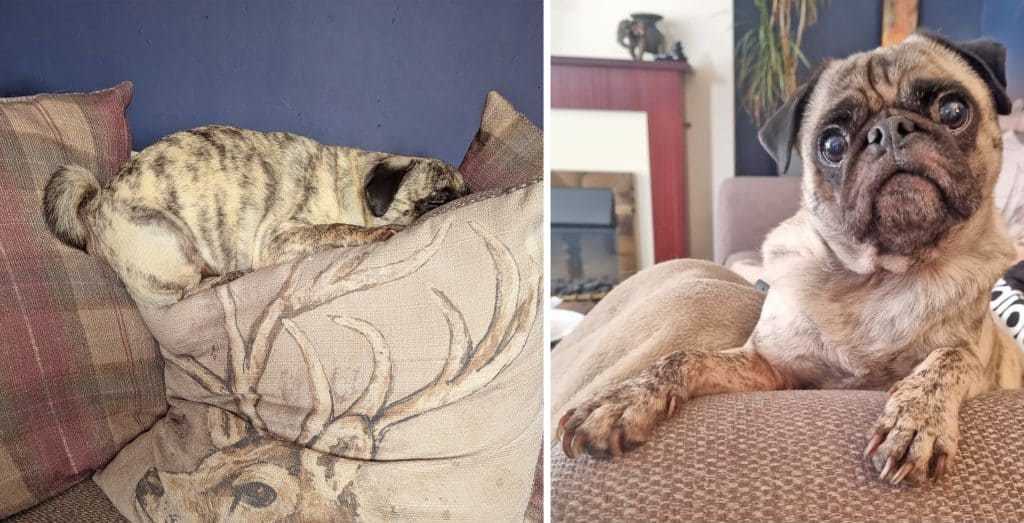
When did you adopt your Ralph?
We adopted Ralph in January 2020. On a bitterly cold Saturday afternoon we drove almost 2 hours to a riding school in what seemed like deepest darkest Somerset. We’d been sent pictures of Ralph and fallen in love with him. Area Coordinator Jane was amazing at ensuring he was a good match, not just for us as a family but for Boo also, so I felt sure everything would be fine. We arrived and met Ralph’s foster family; they handed over what appeared to be an overly excitable bag of eels! I felt sure I was going to drop him; the energy and sheer liveliness did take me by surprise a little! We completed all the formalities and popped our new family member in the back of the car. He absolutely flaked out all the way home, bless him!
What made you decide to adopt?
We’d adopted previously through a little local charity. For me personally, I just feel it’s what I prefer to do. I do worry sometimes that in today’s materialistic society even dogs can become a status symbol or a fashion item, becoming very ‘sought after’ for a period sending prices from breeders soaring. Sadly, with breeds like pugs that have their little ‘quirks’, it’s all too easy to give them up when they become a bit of a challenge to care for.
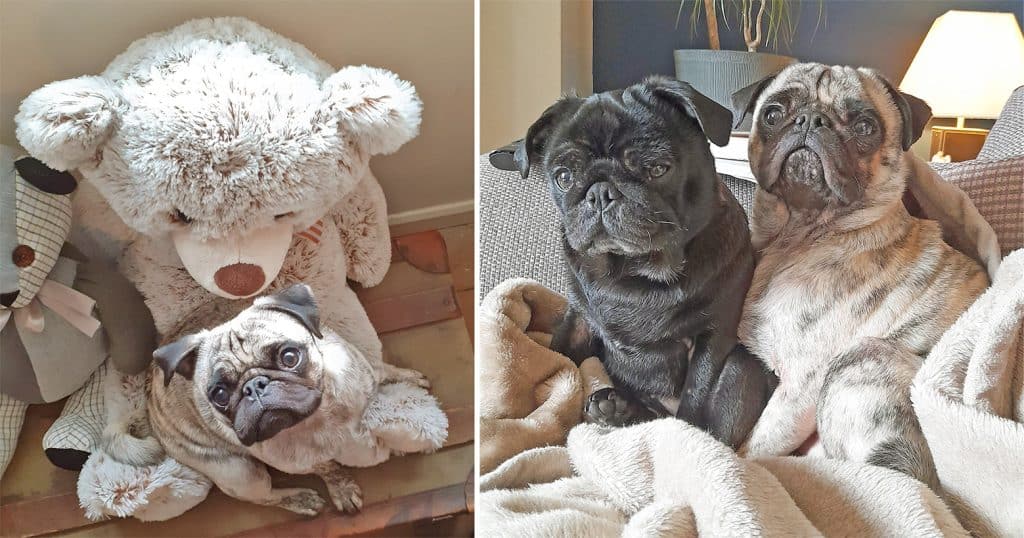
Can you tell us a little bit about Ralph?
Ralph is an absolute character! He has two speeds, full on or asleep. I’d never heard the expression ‘Velcro Dog’, but Ralph is the dictionary definition! He’s just amazing, slightly crazy and we honestly can’t imagine life without him now. Boo is my daughter’s pug and although she isn’t with us all the time, it was obviously important to ensure any potential matches for us suited Boo. Boo is a black female and a year or so older than Ralph. From what I hear, she is a typical black female pug, earning her the nickname ‘Princess Boo’. She’s adorable but definitely has a slight attitude! She’s very much top dog and ensures Ralph knows this in the nicest way possible when she comes to visit.
How did you find the adoption process?
The adoption process was incredibly well managed, and Jane was amazing. We had a lengthy talk about the family, why we were looking at adopting a pug and what the relevant requirements would be, particularly as in a good match for Boo. Jane explained that with Boo’s character, we’d potentially be looking at a younger, more submissive male. Jane called me back sometime later and described Ralph. He sounded so cute. He’s a brindle and in trying to describe him, Jane said he had markings like a tiger or that he should be called Tigger. She sent a photo through and from that moment I just wanted to pick him up! His markings are beautiful and draw lots of comments as people are more used to seeing fawn or black pugs, while Ralph is a mixture.
Anything you think prospective adoptive or foster parents should know?
I would say to make sure you know the quirks of the breed. As mentioned, my daughter Amy wanted a pug for years. She’d educated herself incredibly well and made sure I knew about the breed as I’d be looking after Boo occasionally, I’d never heard of reverse sneezing! I’ve had dogs all my life, but pugs are definitely a breed apart and it’s good to ensure you know all the possible issues to take care of before you commit.
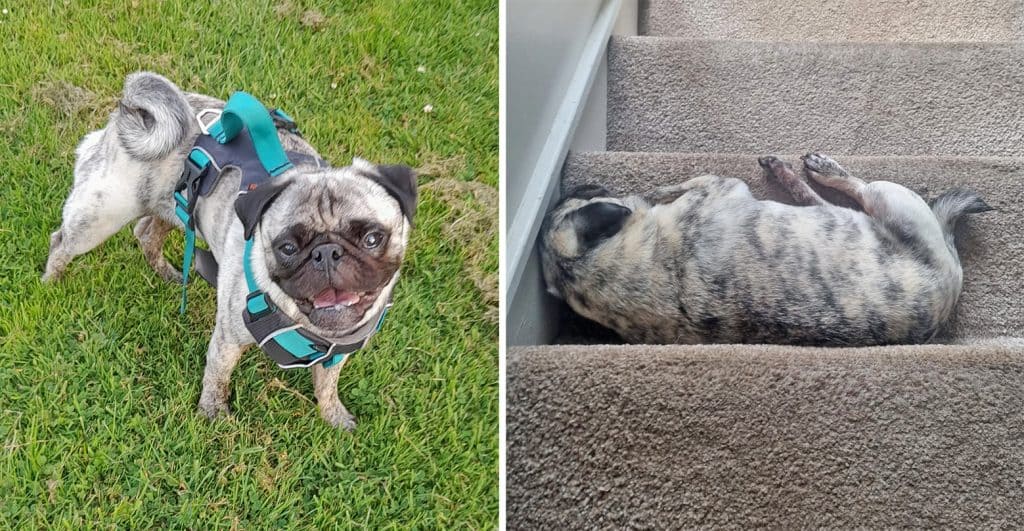
What has life been like since adopting Ralph?
We can’t imagine life without Ralph now. He’s become an amazing little companion for my teenager. Ralph came into our lives just as we were about to go into lockdown in 2020. This period was a cause of extreme anxiety for my child, then only 10yrs old. Ralphs cuddles, slightly mad personality and just his general presence definitely helped. It was incredible to see their bond from day one and Ralph is such a big part of this family now. Thank you so much to PDWRA and in particular, Jane.
******
Do take a look at just a small sample of our happy, successful Rescue & Adoption Stories at:
https://pugwelfare-rescue.org.uk/category/rescue-stories/

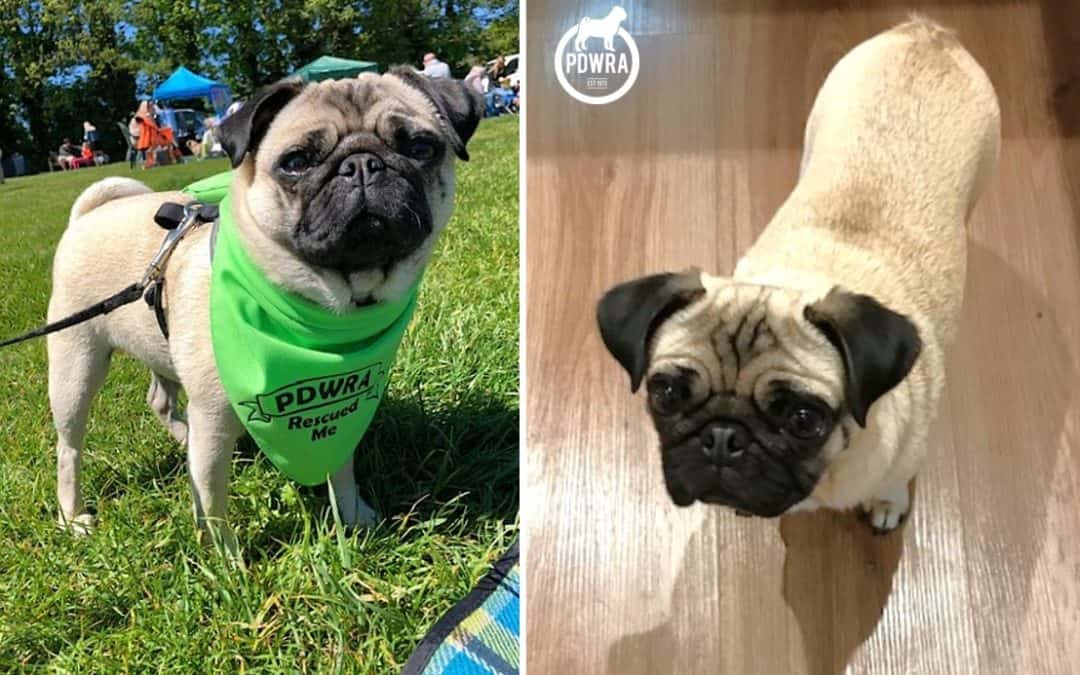
by Yasmin | 15 Apr, 2025 | Blog, Rescue Stories
Laura’s Story of Adopting Ethel
There are two 40th Anniversaries this year, the 40th Anniversary of EastEnders and the arrival of a very famous TV pug – Willie, belonging to Ethel Skinner and more importantly, the 40th Anniversary of pugs entering my life, which was January 1985. I was a young teenager and my family got our first pug puppy, called Honey. I was the start of a 40-year pug adventure ending with the adoption of our very own Ethel! After a few years of having Honey in our lives, my Mum heard about PDWRA and she has adopted at least 4 pugs through PDWRA over the last 40 years, and that’s how I knew about pug adoption.
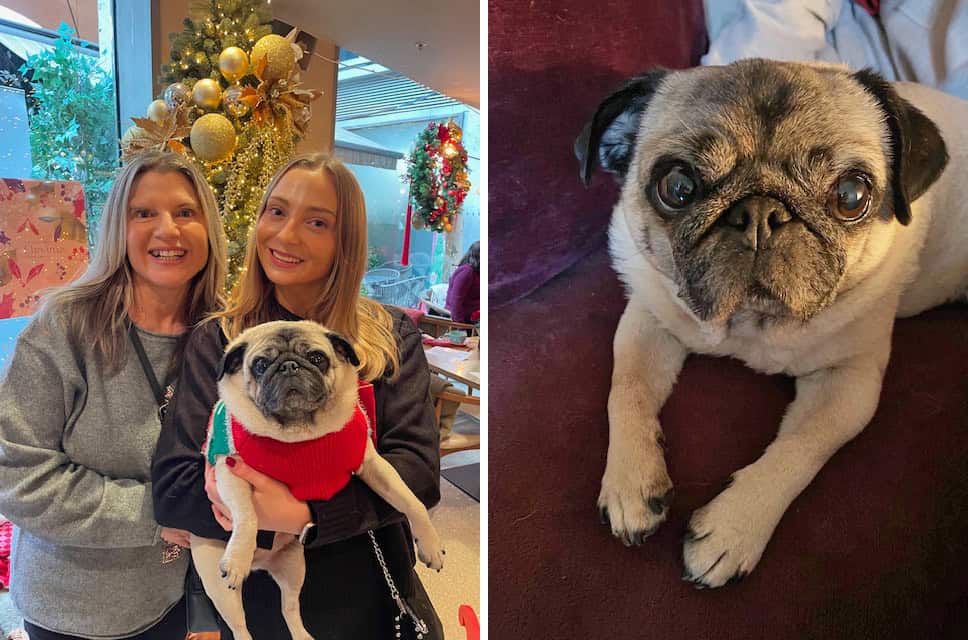
Due to work commitments and family life, a dog was not a viable option for our family for a number of years, but in 2018 my husband was made redundant and took a job with more flexible hours. We then thought about the prospect of getting a dog and I made the first move to contacting PDWRA. This was around September 2018 and it wasn’t too long until we were contacted for a home visit and the ball was rolling. My mum had warned it may be sometime before we heard anything but 2 or 3 weeks later a call came through from Paula Parke regarding a puppy pug that had become available. We weren’t too sure about a puppy, preferring a 2–3-year-old dog and Paula then mentioned a little pug called Ethel. “Tell me more” I said, and she did. 2 weeks later we were on our way to collect our very own little ‘Willie’! We can still remember the first time seeing her now, a tiny little thing bounding into the room after a tennis ball, which was as big as her head! From that moment on, we were smitten. We drove home to where her 2 human sisters were patiently waiting and life changed forever, for the better. Ethel settled in reasonably quickly, we had originally said – “no sleeping in our bed”, but those big eyes and sad little face – 24 hours later she was on the bed in between us snoring away on her favourite soft blanket and she’s never looked back!
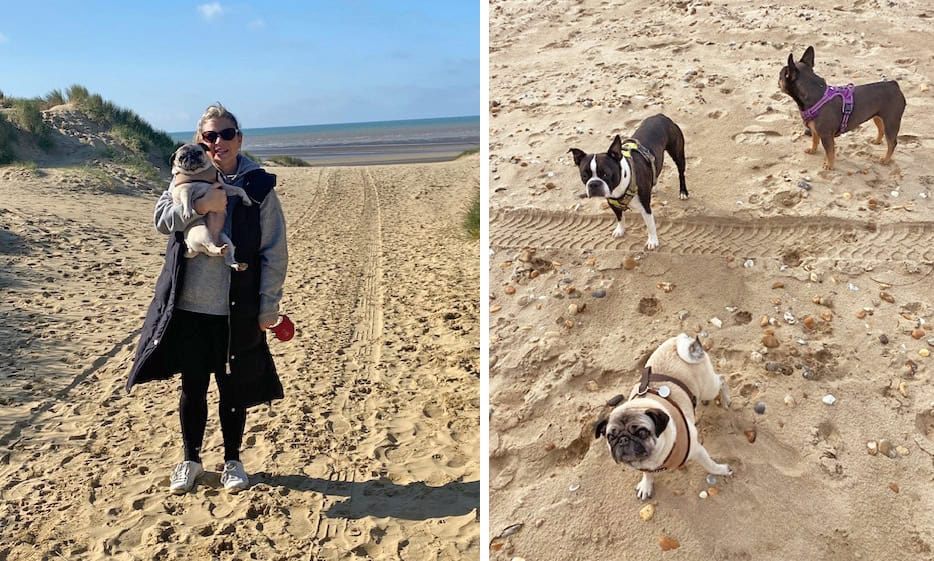
Ethel has had a few health issues, like all pugs she suffered with eye ulcers and after a particularly bad bout of them we spoke to the PDWRA who were excellent in referring us and helping with the costs, to an expert eye surgeon. Ethel had a cornea graft in the summer of 2021, it was a worrying time and after a few weeks of wearing the cone, numerous trips back and forth to the vet and LOTS of eye drops, the result was amazing and well worth having done.
Ethel was a tiny 5kg when we adopted her at the age of 2 and half, she has now been in her forever home with us for 6 years and due to her love of cheese, crisps, apple, chicken, roast beef, the list goes on, her weight has slowly crept up. She enjoys 2 or 3 walks a day, dry at an ambient temperature is always preferable! Ethel has also “enjoyed” a few trips away, she’s been to Devon, where she very much enjoyed trying to snack on sheep’s poop, and climbing up the various Tor’s. She’s also been to Rye and Camber Sands, where she’s really enjoyed a trot on the sand with some doggy friends of ours, but always looks at them like they are slightly mad when they go running off into the water – “wet paws, not for me” she says! But as much as she’s enjoyed her trips away, you can tell Ethel’s absolute favourite place is in her own home, on the settee, next to either me or her Dad, squashed up next to one of us snoring away until a crisp packet rustles and you’ve never seen a pug move so fast!
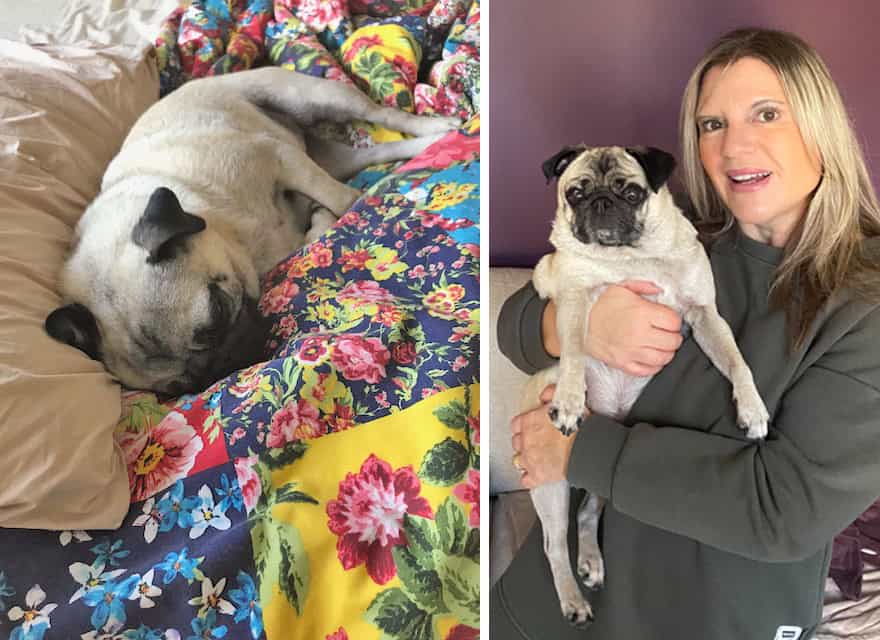
Ethel is a lovely little pug, she is loving and attentive but at the same time can give you that moody side eye pug treatment when she feels like it! She’s 9 years old now, a senior, but still has quite youthful looks, even if tinged with some grey. She can still chase a squirrel or even an aeroplane in the back garden and jumping up at the TV when any non-human is on – not a problem! And even though crisps HAVE to be shared and nature programmes are a no-no, we wouldn’t have it any other way! Here’s to another 40 years of PDWRA and pug love.
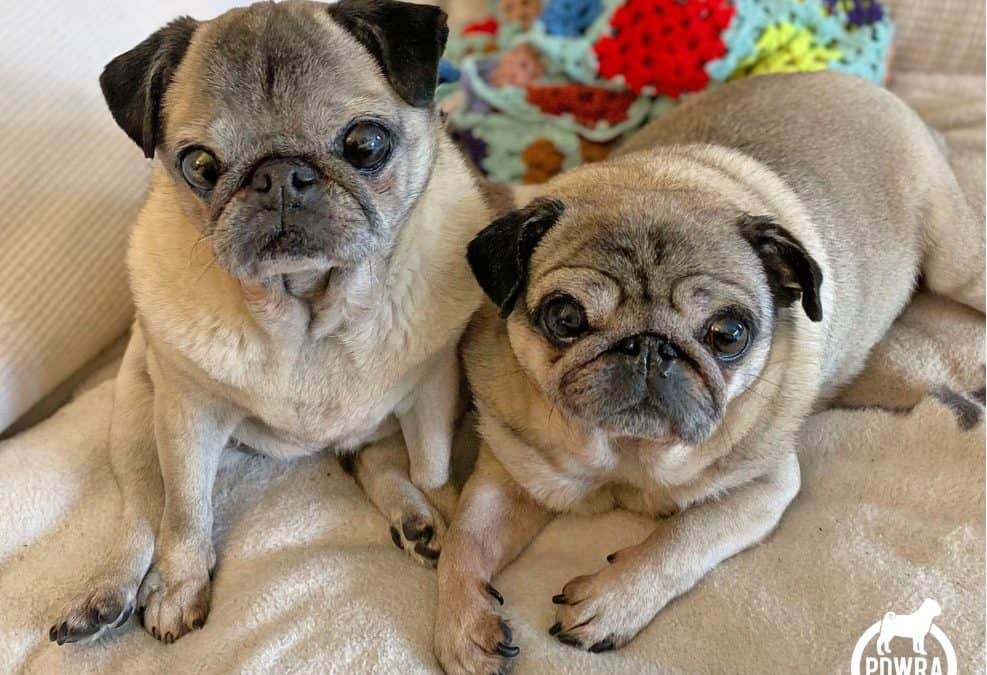
by Yasmin | 14 Apr, 2025 | Blog, Rescue Stories
Sam Harrington-Lowe is Director, Founder and Managing Editor of Silver Magazine, an edgy, exciting online magazine for the 50+ market where she examines what your Midlife Coming of Age is, why it’s so amazing, and how you can get there!
Sam is a volunteer for PDWRA who fosters occasionally as well as transports whenever she can and there’s a need for it in her area. In March, Sam had an article published talking about how she has recently fostered a blind, deaf 15-year-old pug. She says that whilst this has made life a little more complicated it’s also been rather magical…
Miss Bones was Sam’s new arrival. She says that “Her owner died. Imagine being fostered out at 15 after a lifetime with one family. When she arrived she was frightened and in flight mode.
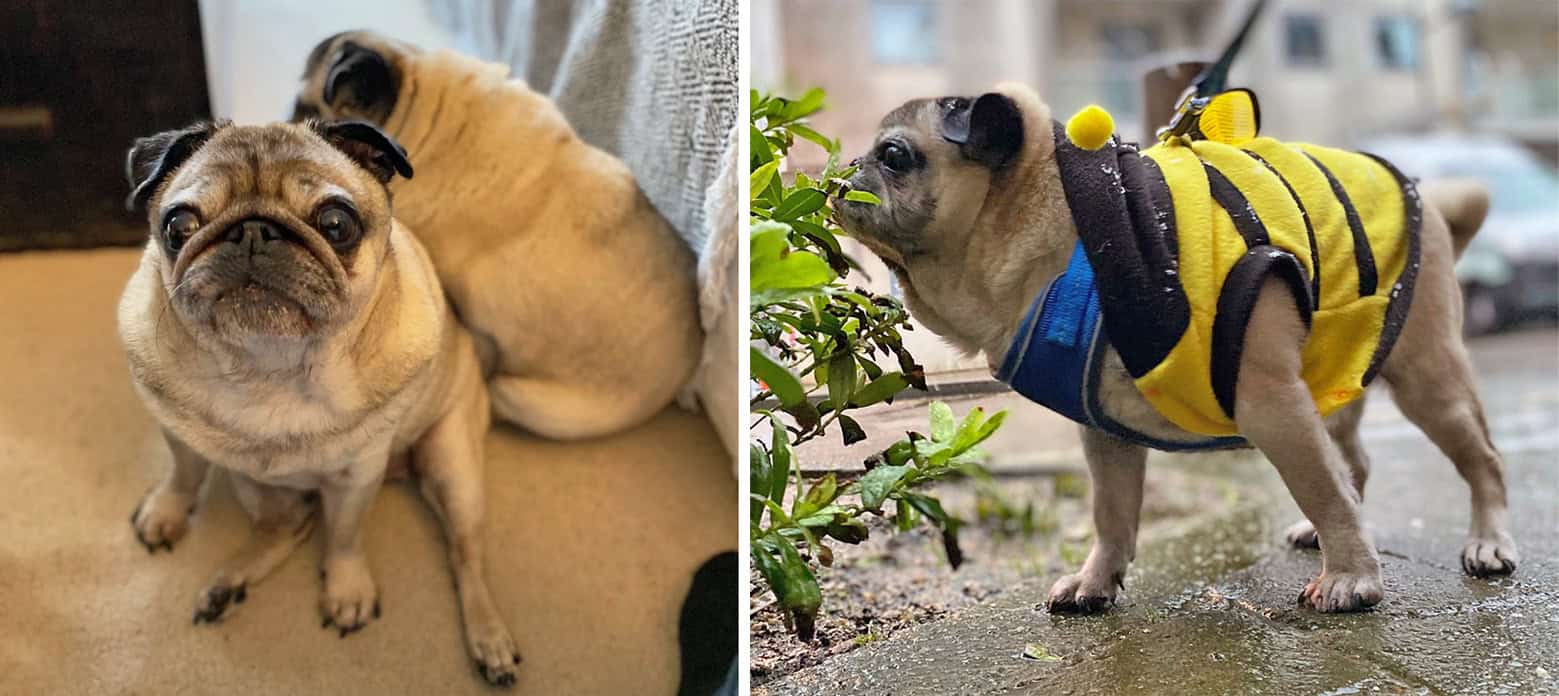
Incumbent Alice in front of Miss Bones.
Sam already had a pug, Alice Pickle, who we all knew could be a little diva and was fussy about fostering other pugs so Sam had to be careful offering sometimes! So, although Alice Pickle wasn’t a huge fan of Miss Bones at first, especially not understanding that Miss Bones is blind and why she bumps into her, it wasn’t too long before they starting to sit closer together.
“As for Miss Bones, she barely knows Alice is there. It’s very hard for a pug that can barely even see if it’s day or night. After a day or two crashing around trying to escape, the pheromone diffuser and industrial strength hemp oil kicked in and she settled, found her stride, started to trust us, and we formed some routines.”
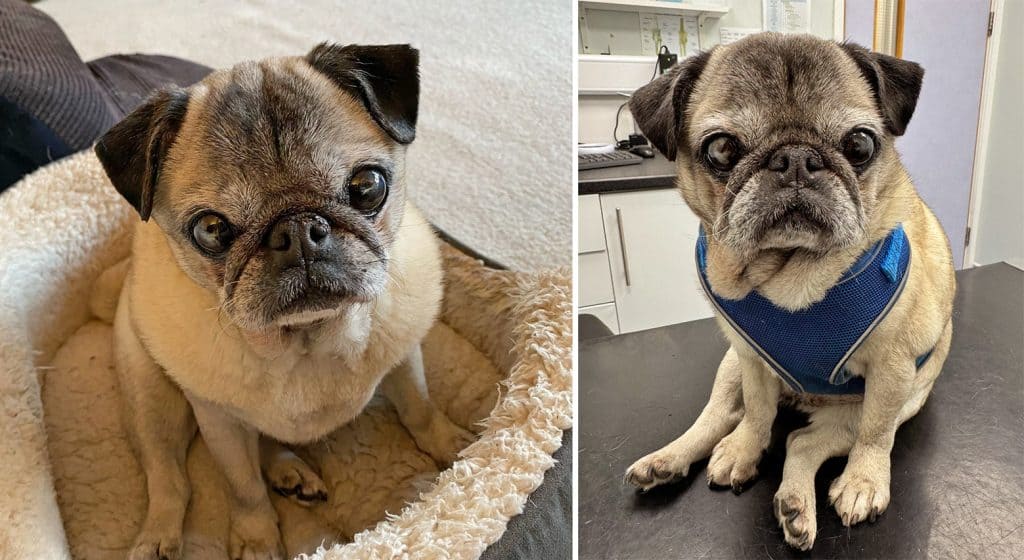
“Miss Bones is amazing. She’s mapped out the ground floor of the house, doing laps over and over, touching things with her nose to test the boundaries, and walks around it without hesitation now.
We have to be careful of not ambushing her by leaving things lying around where she’s not expecting them. Added bonus is that my daughter now has to be tidier, or Miss Bones goes a cropper…”
As you can tell, with time and adjustments to help each other, Miss Bones found a very happy, secure and loving home with sisterly companionship in Alice Pickle. Thanks Sam!
Read Sam’s full article here
You can find out more about Silver Magazine here
********
If you could Foster and make an enormous difference to lives, please see our webpage & apply there:
Fostering

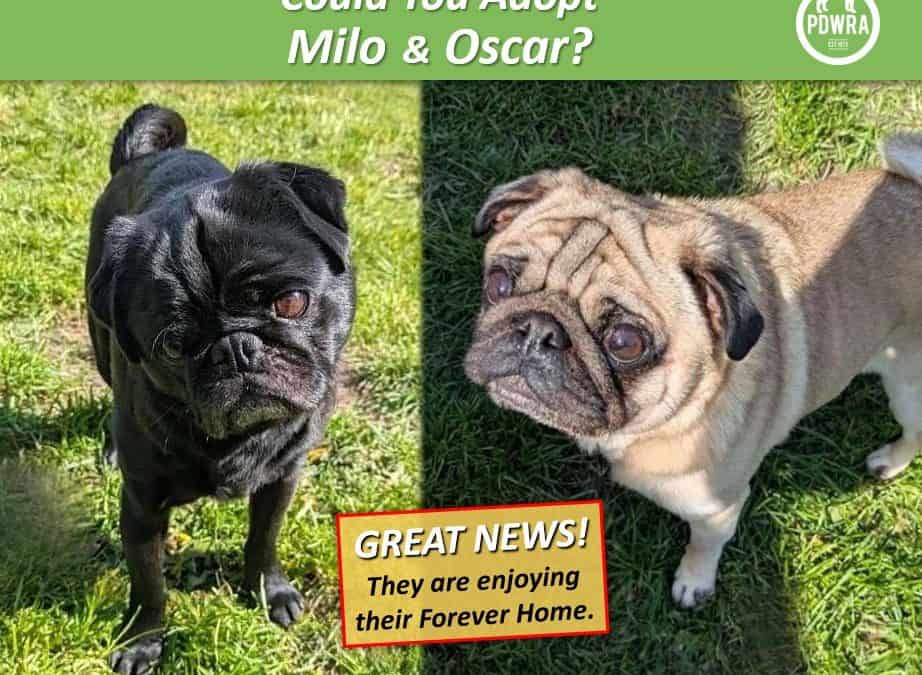
by Yasmin | 13 Apr, 2025 | Pug Home Appeal, Blog, News, Rescue Stories
👏 THANKING ALL APPLICANTS! 👏
We are delighted to say that Oscar & Milo are comfortably in their Adoptive Home!
******
APPEAL INFORMATION:
Bonded boys Milo and Oscar are keen and ready for their Forever Home together!
Due to long working-hours changes at home, this delightful pair of boys, who can live with children and other sociable dogs are looking for their adoptive home.
We’re informed, No cats though!
Oscar is four years old.
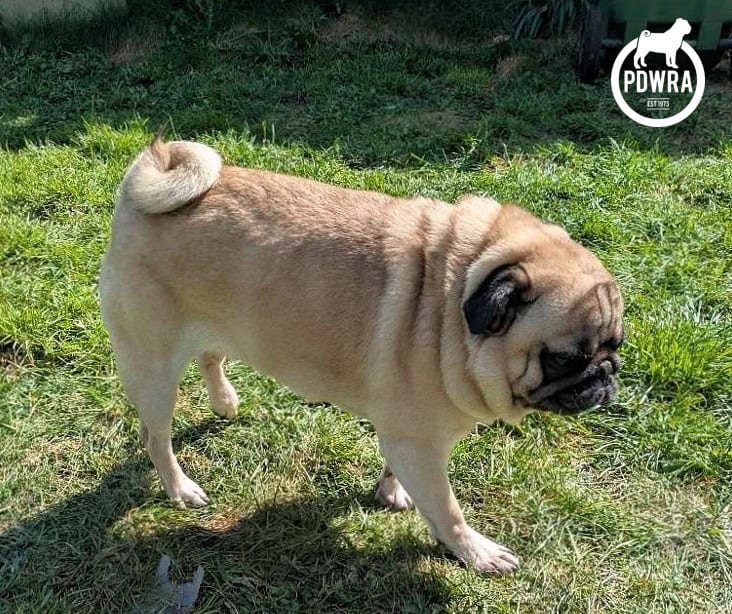
and Milo is five.
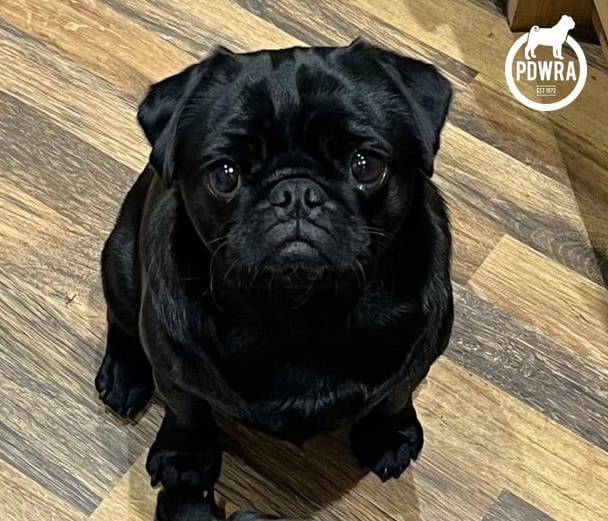
Both boys are neutered and vaccinated.
They are affectionate and love a cuddle.
They are crate and housetrained.
If you have any specific questions about them, please email Jane at: central@nullpugwelfare-rescue.org.uk
Our Guidelines for Adopting, including Bonded-Pairs, are at: https://pugwelfare-rescue.org.uk/adopting-a-pug/
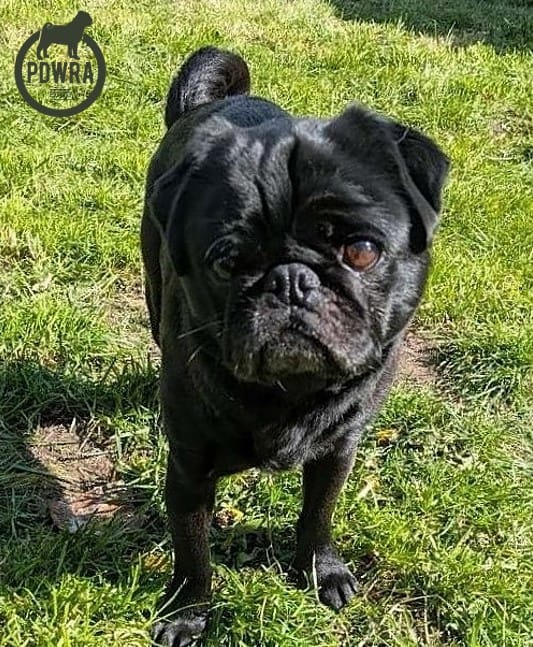
Thank you!
******
To see the difference adoption can make to your life and theirs, see some of our heart-warming Rescue & Adoption Stories for Bonded-Pairs at:
Perfect Pairs | The Pug Dog Welfare & Rescue Association

by Yasmin | 4 Apr, 2025 | Blog, News, Fundraising
👏 ** THE PRIZE DRAW has been made – Raffle Closed ** 👏
******
It’s looking like the Most Popular Raffle Prize we’ve had so far, this year!
Brand New in the box, the latest model, NINJA WOODFIRE PRO CONNECT XL ELECTRIC BBQ GRILL AND SMOKER.
RRP £449. It could be yours, for just £2 per raffle ticket.
The future of outdoor cooking – controlled by your phone this will make your Summer entertaining!
From the UK’s No.1 BBQ brand, Pro Connect app controls your BBQ & monitors cooking progress from your phone.
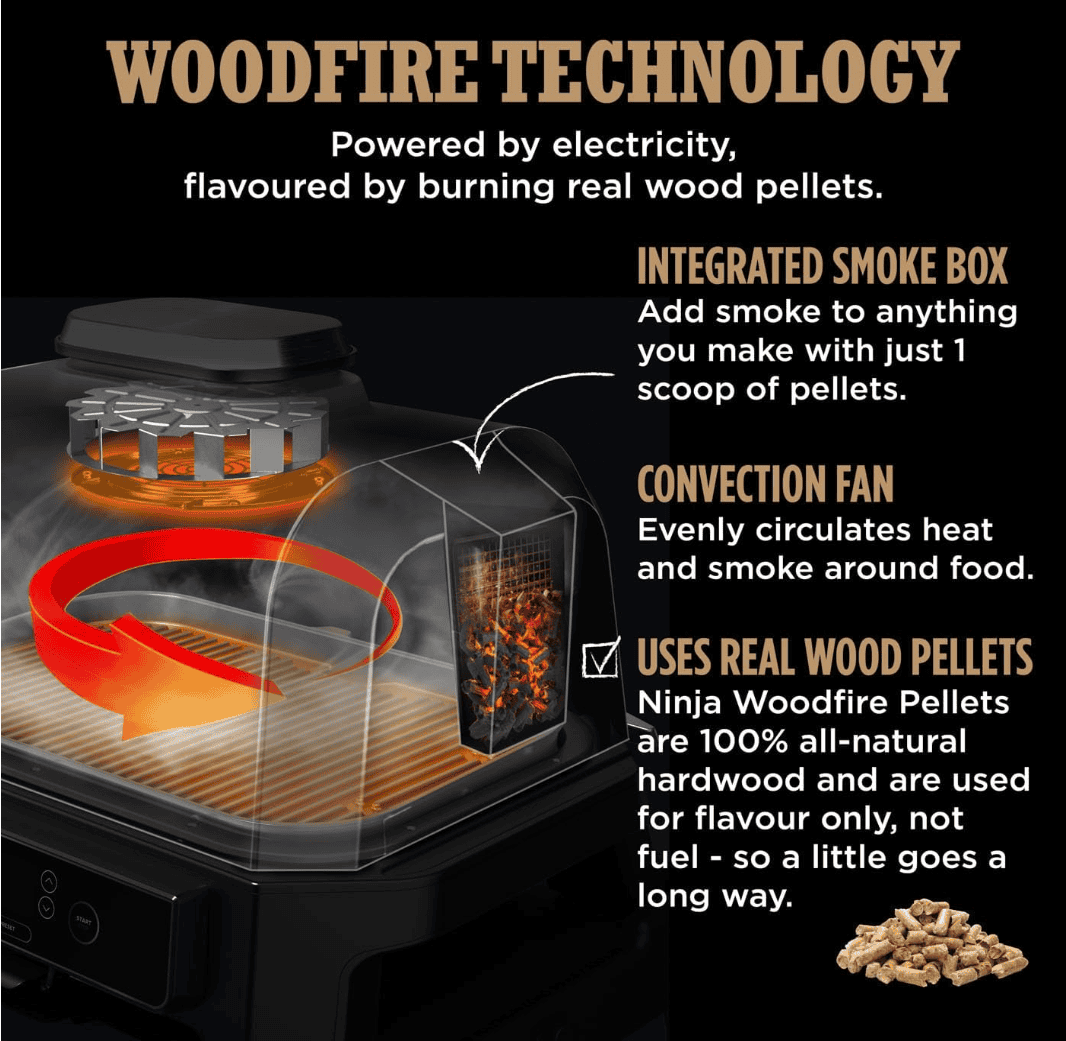
It burns natural wood pellets for authentic smoky flavours & the large grill fits up to 10 burgers, 40 hotdogs or 2 whole 3kg chickens
Electrically powered & weather resistant, for year-round outdoor use.
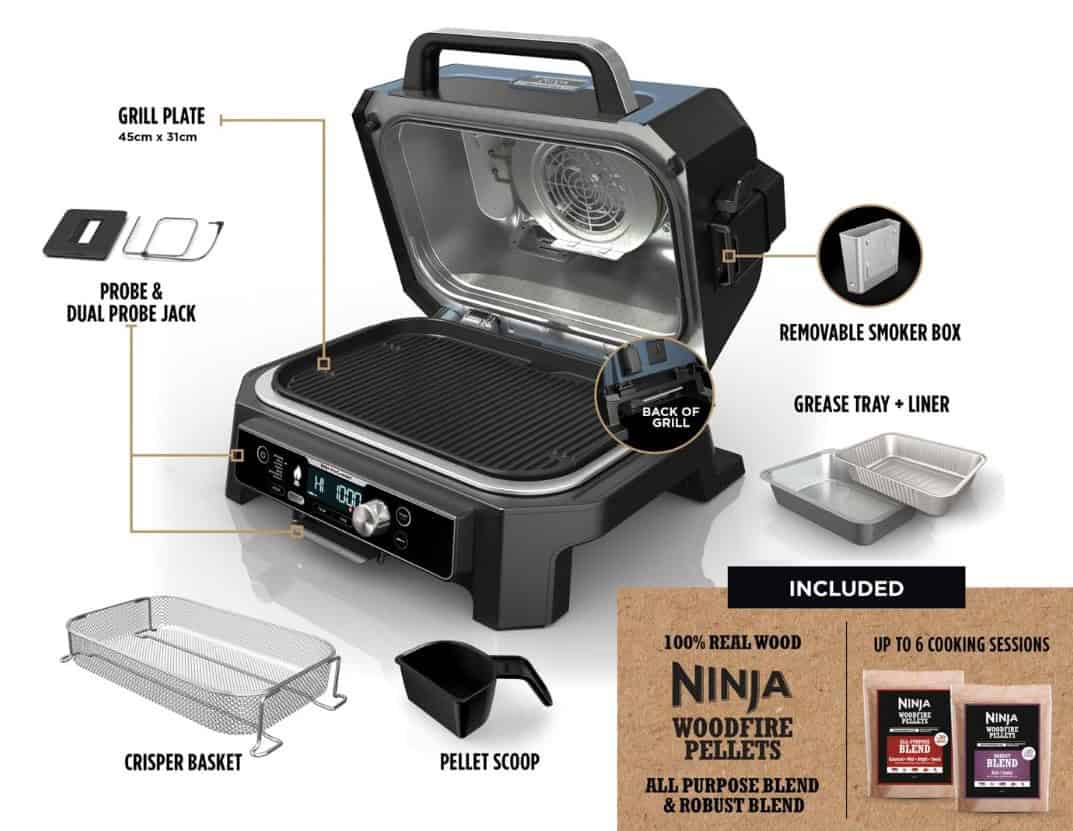
This fantastic prize could be yours if you join our Raffle in PDWRA’s Facebook Mega Auction Group: (6) PDWRA Mega Auction For Pugs In Need | Facebook
**********
The Draw will take place by video, at:
7pm on Wednesday 9th April
with free delivery to the Winner’s UK home address.
**********
For full Prize details and to buy Tickets, please join our Facebook group if you are not a member yet.
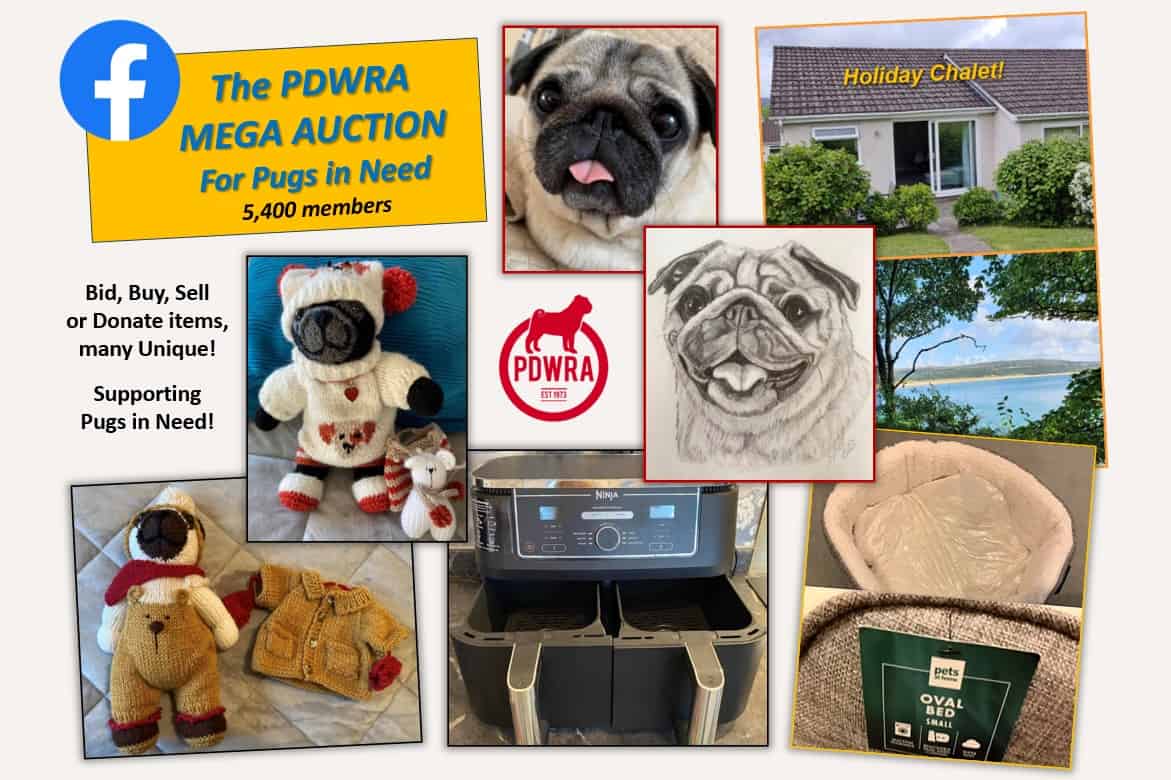
Ticket acknowledgements will be made within the Mega-Auction Facebook Group only.
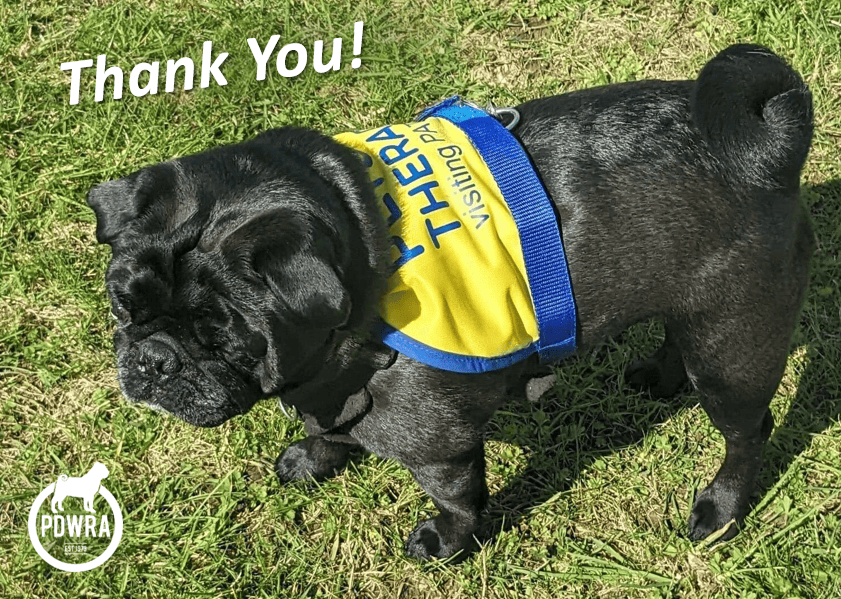
**********
For more information about Fundraising, please see our webpage: https://pugwelfare-rescue.org.uk/fundraising-events/
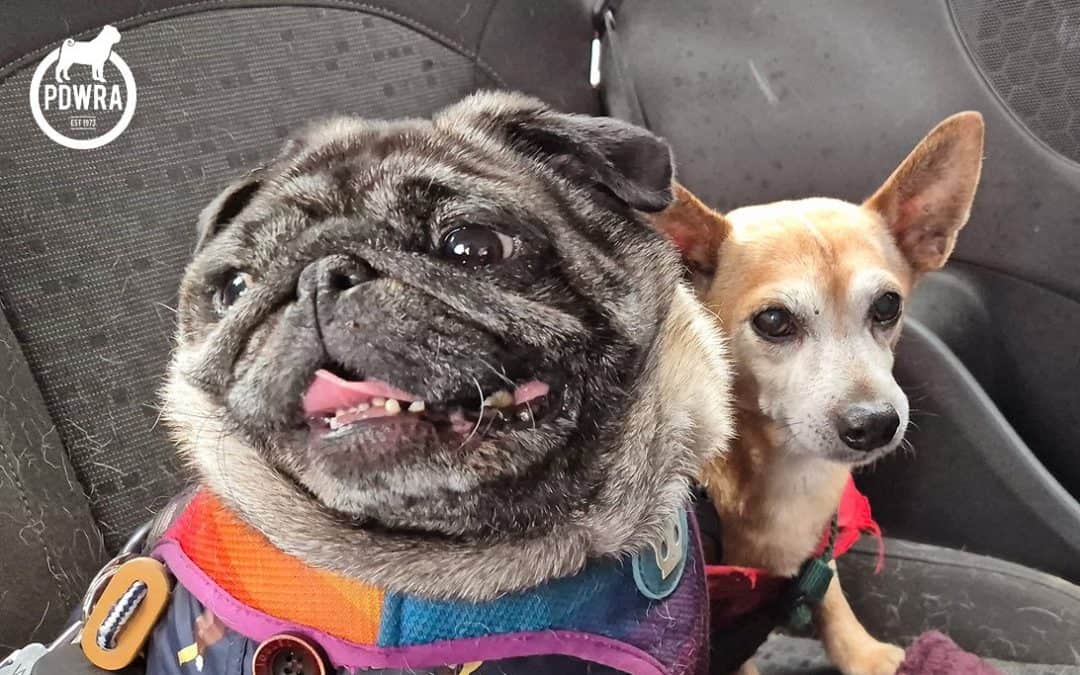
by Yasmin | 2 Apr, 2025 | Blog, News, Rescue Stories
Hello everyone. My name is Esme and I first came to PDWRA a few years ago.
I’ll start with the day I was told I had a new Furever Home. I was transported from my foster home to another lovely volunteer’s home, and from there I was collected by Myra and her daughter, Melissa.
I was taken to my new home where I met my new brother, Rupert (a Jack Russell/Chihuahua cross). As I explored the house, I found that there were dog beds in each room, one for each of us, (but sometimes Rupert and I like to share together) and a large garden, which has lots of birds visiting. I love to chase birds!
I also checked out the most important room, the kitchen… I found that the menu was quite delicious!
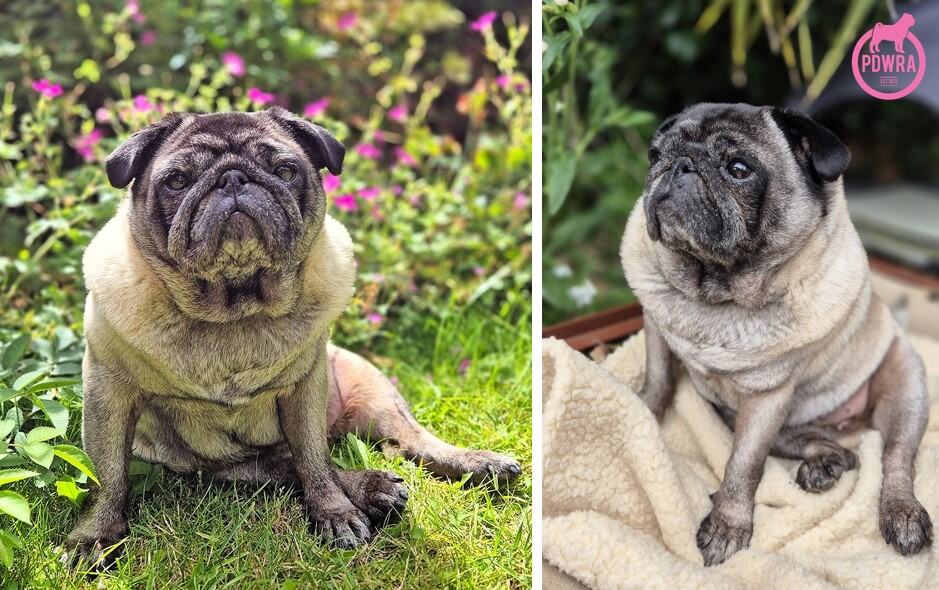
It didn’t take me long to find the best spot on the bed that night, with my own pillow, and I must say I slept well. Two days later though, I did not feel good, and my new family realised that I had a problem with my eye, so off I went to the vet. Apparently,
I had an ulcerated cornea, and when the standard treatment didn’t work, I was referred to a specialist, who told me that I needed expensive surgery imminently, or I would lose my eye. As it was a pre-existing condition, the PDWRA agreed to pay the costs. I was then forced to wear the cone of shame for weeks, but thankfully, with the swift action from my humans and help from PDWRA I have been able to keep my eye.
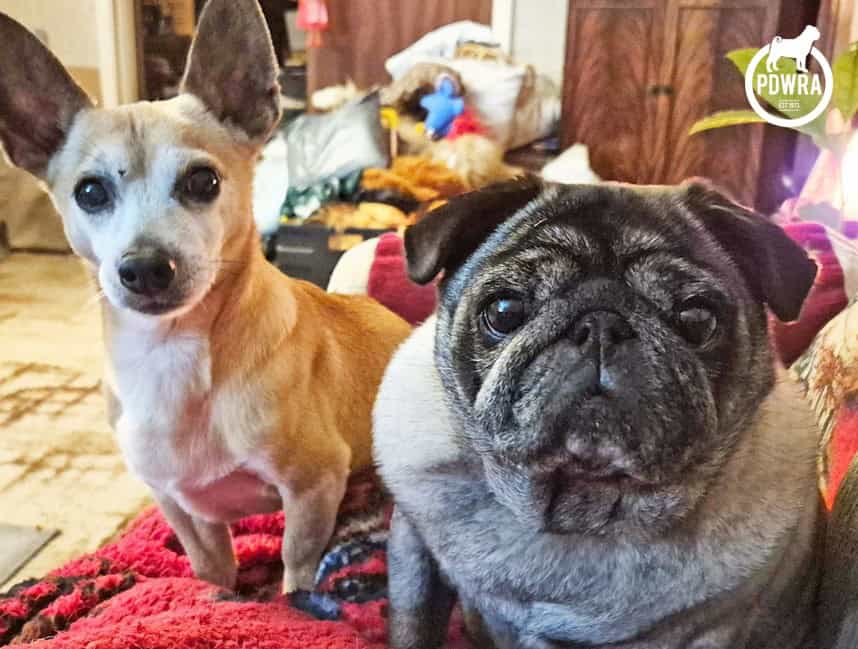
A little while later I began to take interest in Rupert’s toys and so Melissa gave me a toy of my own, and I love it. I don’t play with it very often, but I love to give it a chew from time to time.
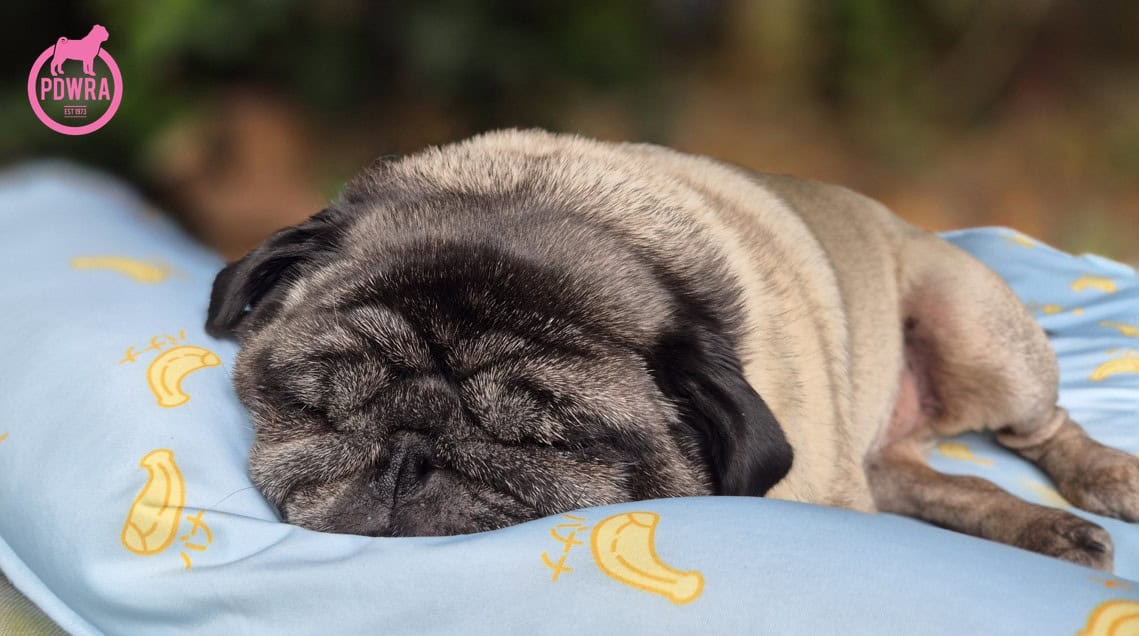
When I first came here, I was not used to walking and I had a terrible fear of traffic, but both Myra and Melissa were very patient with me and slowly built up my walking distance, and took time to let me get used to traffic.
I still have a go at big vans if they are too close to me but I can now walk by the road without having to be kept on a short lead. I do still have occasional night terrors but even they have got better the longer I’m here.
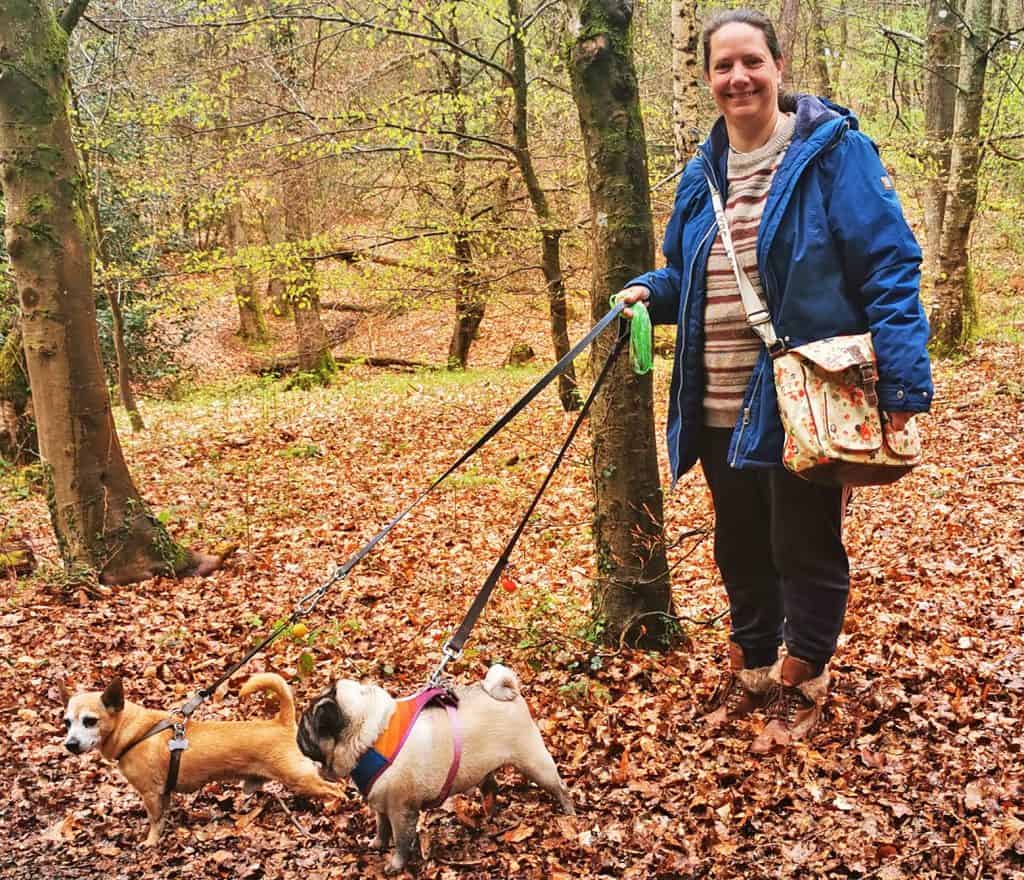
Sadly, Myra became ill, and so Melissa took over our care as well as looking after her Mum, who we then sadly lost. Melissa has now become our sole Human and she has made sure that Rupert and I lost nothing but also gained so much, as we now go on doggy adventures to the forest and other local spaces and we’ve been on holidays to the New Forest and Cornwall.
I can now walk up to 7 miles in a day, not bad for a Pug who had never been walking before! Melissa is an actor and film maker and I have actually appeared in a couple of her films, and have even appeared in a travel show for Korean TV!
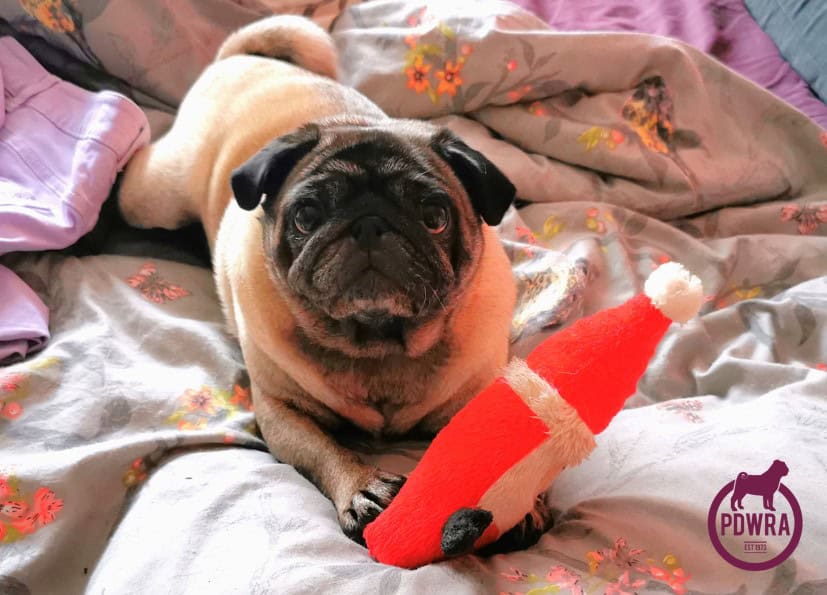
Thank you PDWRA for all you have done for me and others like me, and I hope that you continue the good work for other Pugs.
For more stories like Esme’s, please see some of our rescue stories at:
https://pugwelfare-rescue.org.uk/category/rescue-stories/

by Yasmin | 31 Mar, 2025 | Blog, News, Pug Health
Spring is here!
We’re all glad for the drier, brighter, warmer days bringing with it NEW temptations for our furry friends indoors and out. So as usual we need to be vigilant, for them!
Outdoor hazards:
We’re likely to be keen to be outdoors with winter behind us. Springtime activities such as gardening and picnicking can expose pugs to potential hazards like pesticides, fertilizers, and sharp tools/objects.
So, keep a close eye on your pug when they’re outdoors to ensure they’re not exploring things they shouldn’t be, and are in a safe environment.
Toxic Bulbs & Plants:
Many different plants & bulbs commonly found in the home, gardens and outdoor areas can make your dog ill. Some of these are highly poisonous, such as lilies, tulips, and daffodils, if ingested. while others may only cause a mild tummy upset. Incidents of poisoning from spring bulbs are most likely to occur from dogs eating the bulbs in spring when they begin to flower and autumn when they are planted.
It’s best to keep your pugs away from these plants, to prevent accidental poisoning. Please see more examples of harmful and harmless plants the bottom of this webpage.
There’s a whole array of OTHER hazards, including: weed killer, pesticides including slug pellets, compost bins, even grass cuttings!
Allergens: Just like humans, dogs can suffer from seasonal allergies triggered by pollen, grass, and other allergens that are more prevalent in the spring. Symptoms may include itching, scratching, sneezing, and watery eyes.
Please see: Atopic Dermatitis (Itchy skin!). | The Pug Dog Welfare & Rescue Association (pugwelfare-rescue.org.uk)
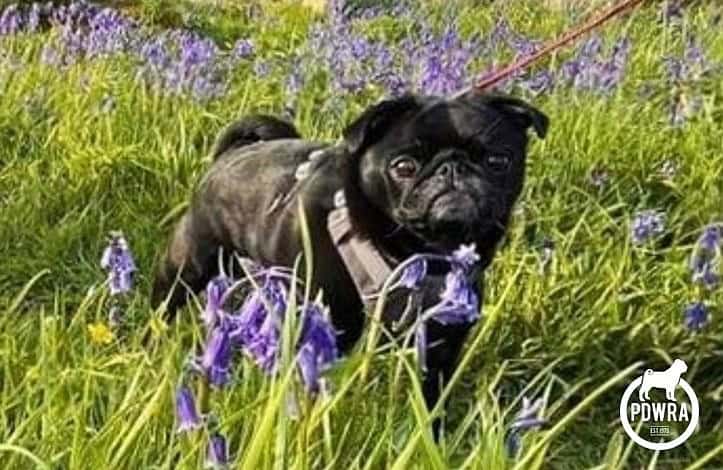
Ticks and fleas: Warmer weather means an increase in ticks and fleas, which can transmit diseases such as Lyme disease and tapeworms. Pugs, with their wrinkled skin, can be particularly susceptible to flea infestations if proper preventive measures aren’t taken.
Indoor hazards:
With Easter, it may be worth reminding visitors or children who may not be as aware of the hazards, as we are, so everyone can enjoy this time of year, safely.

Chocolate poisoning: Easter often involves chocolate eggs & treats, which are toxic to dogs if ingested. Make sure to keep all chocolate out of reach of your pug and be cautious about where you hide Easter eggs if they contain chocolate.
Most of us know about keeping Easter chocolate away from temptation but our dogs will endeavour to seek things out with their highly sensitive sense of smell.
Theobromine found in chocolate is a stimulant. It may cause excitability or muscle twitching, tremors, even fitting, or they may have an increased heart rate. They may initially be sick, but you must never try to make them sick.
– If vomit is frothy and foamy it could get into their lungs, making matters worse.
– Other signs might include drinking a lot, drooling, not walking in a straight line and fast breathing. If enough is eaten then the effects can be severe or even fatal.
Some sugar-free chocolates contain Xylitol, also branded as Birch-sugar, which is an artificial sweetener especially poisonous to dogs. It can cause a dog’s blood sugar level to drop to dangerous levels, also possibly liver failure.
Also, while chocolate foil wrappers are not poisonous, they can cause an obstruction if eaten. This can be dangerous enough to require surgery.
Signs of an obstruction may include being sick, being tired, they may be be off their food, or finding it difficult to go to the toilet!
If you suspect your pet may have eaten chocolate, keep the packaging and call your vet immediately. Help them regarding the type of chocolate that’s been eaten (dark, plain, milk, white etc.) and how much has been consumed.
If you suspect your dog may have eaten chocolate, contact your vet immediately, keep the packaging to help them regarding the type of chocolate that’s been eaten (dark, plain, milk, white etc.) and how much has been consumed.
To learn more about chocolate toxicity and the signs and symptoms:https://www.pdsa.org.uk/pet-help-and-advice/pet-health-hub/conditions/chocolate-poisoning?
Overeating Easter treats: With Easter celebrations often come feasts and treats, which can lead to overeating and digestive issues for pugs. Be mindful of the types and amounts of food your pug consumes to prevent obesity and gastrointestinal problems.
Food Hazards.
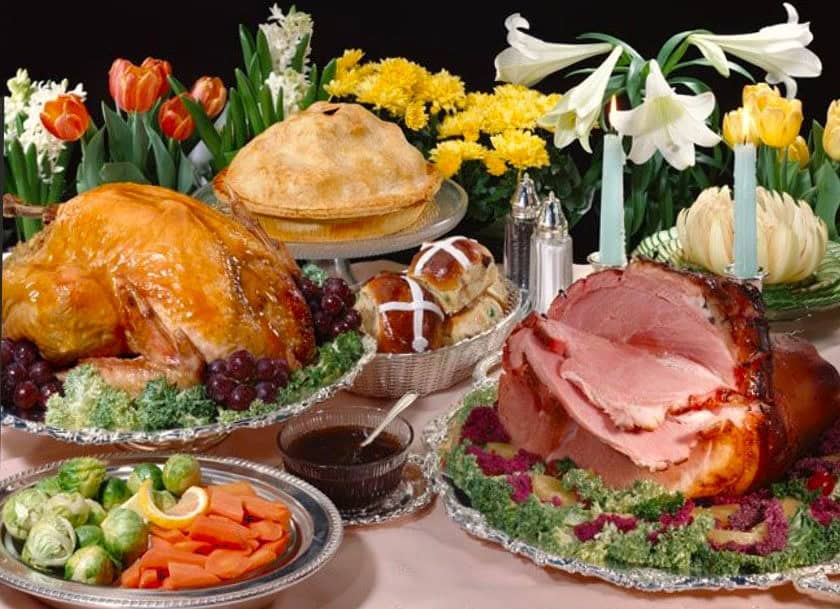
– Traditional roasts where cooked bones can easily splinter.
– Stuffing, gravy, anything which may contain onion, chives, garlic.
– Fruit or Simnel cake, Hot-Cross buns, anything with sultana’s and raisins (grape family).
– Other foods, such as certain nuts, blue cheese, fatty and salty foods.
For more on Easter dangers: https://www.thekennelclub.org.uk/easterdangers?
Spring Cleaning.
If you are Spring-Cleaning, make sure that products are inaccessible to your dog and that they are kept away from areas while being cleaned, or have recently been cleaned.
For more information, please see: Poisons | Dog health | The Kennel Club
Including a comprehensive list of poisonous plants: Poisons in your garden | Dog health | Kennel Club (thekennelclub.org.uk)
********
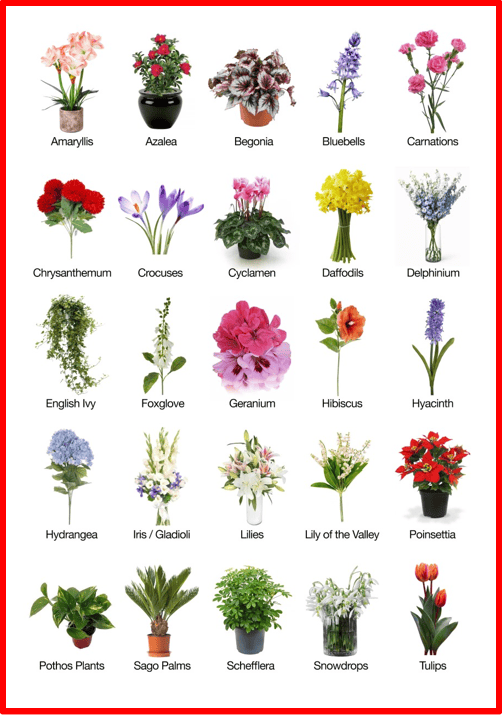
On a sunnier note, here are some, from many, that are regarded to be safe for our dogs:
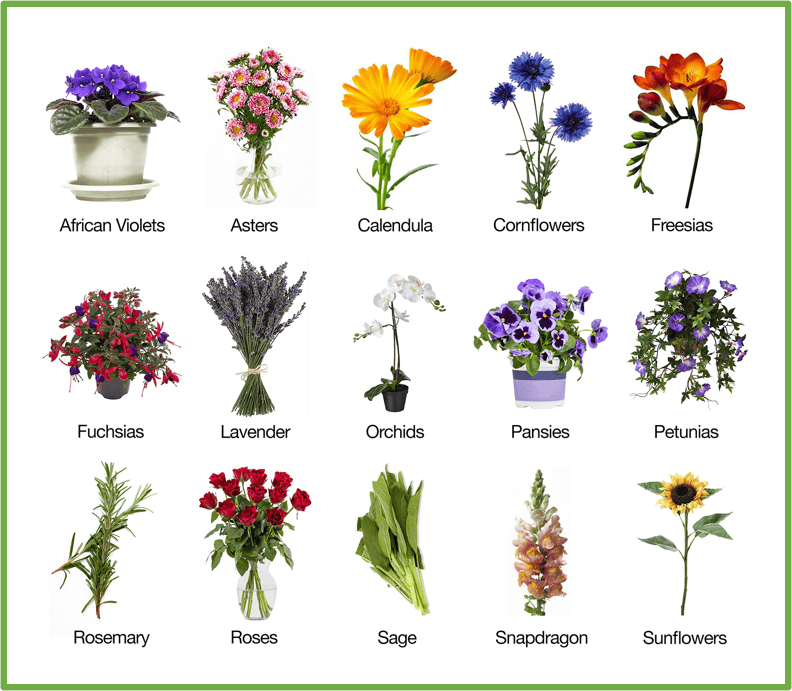
If you suspect your dog might have ingested anything that is appearing to make them ill, contact your vet immediately.
********
Seasonal Hazards for Pugs






































































